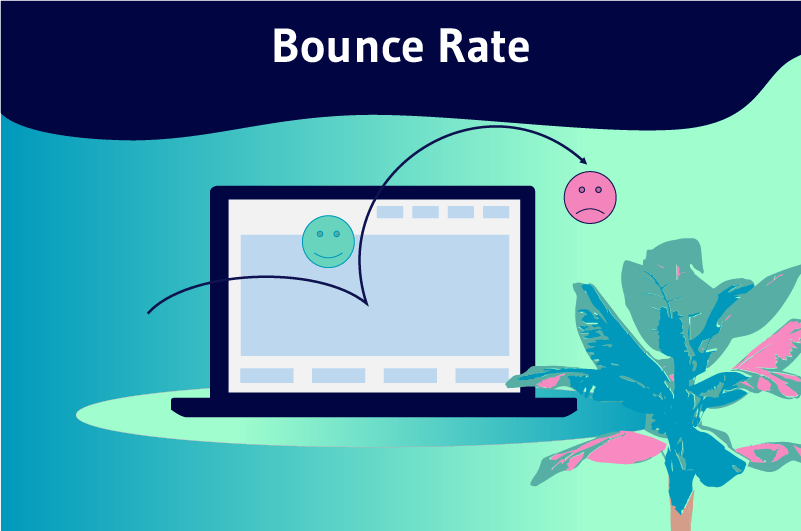Bounce Rateis the rate at which users access a page on your website and leave it shortly after without taking any further action. Reflected as a percentage, this statistic is the average number of bounces across all pages on the website divided by the total number of visits to the entire site.
When Google ranks websites, it uses its algorithms to try to identify the sites that the best needs of users. This means that it takes engagement metrics into account, including bounce rates.
This ranking factor assumes that sites with a good bounce rate are better at attracting readers and encouraging them to engage more with content.
When users interact with a site appropriately, Google assumes that the site meets their intent and needs.
To help you get a good bounce rate, this article will provide clear and precise answers to the following questions:
- Why should you consider bounce rates?
- How do I access this important metric in Google Analytics?
- How to fully measure your bounce rate?
- How do you recognize the right bounce rate for your business and industry?
- What are the tips for auditing your bounce rate and improving the percentage?
Let’s start!
Chapter 1: What should be understood by a bounce rate?
In this first chapter, we will cover the basic notions you need to know about bounce rates, namely:
- What are bounce rates?
- How does Google Analytics calculate it?
- Why should you care?
We begin:
1.1. What are bounce rates?
When someone visits your website and does not take any action on the page before leaving, it is called a bounce. So, your bounce rate is a percentage of people who landed on a page on your website, but did nothing on that page.
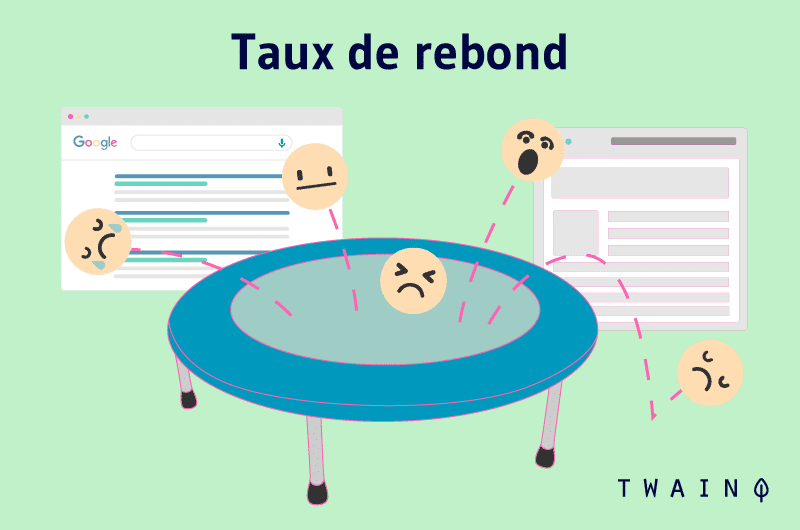
Did nothing, i.e.:
- Do not click on a link to another page
- Do not press a “Learn more” button
- Do not search your site
- Do not complete any questionnaires or requests for information
- Etc.
Since no action was taken, Google Analytics does not receive a trigger.
From Google’s side, a high bounce rate can be a signal that your website isn’t doing what it’s supposed to. That is, visitors don’t engage because of lack of satisfaction.
On your end, you can use it to measure the quality of a landing page or your audience.
Sometimes it may not be the landing page that is the problem, but rather you targeting the wrong person! This is to say that it is possible that you are attracting visitors who are simply not relevant to your website and its offers.
Remember that the bounce rate of each individual page contributes to the overall website bounce rate.
To help you better understand this concept, we will see how Google Analytics performs the calculations to obtain the bounce rates.
1.2. How are bounce rates calculated by GA?
The bounce rate of your website in general as well as for each of your pages is calculated automatically by Google Analytics.
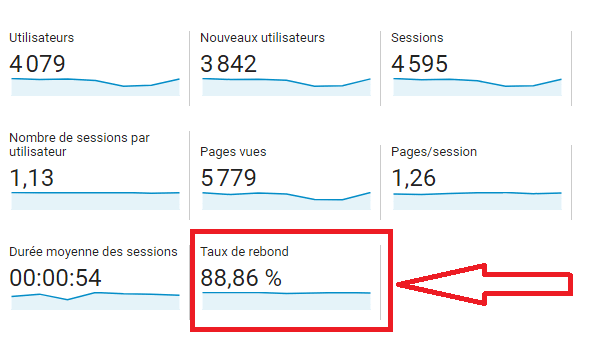
To help you better understand this indicator, let me show how Google designs it.The calculation of the bounce rate by Google can be summed up by a very simple equation:
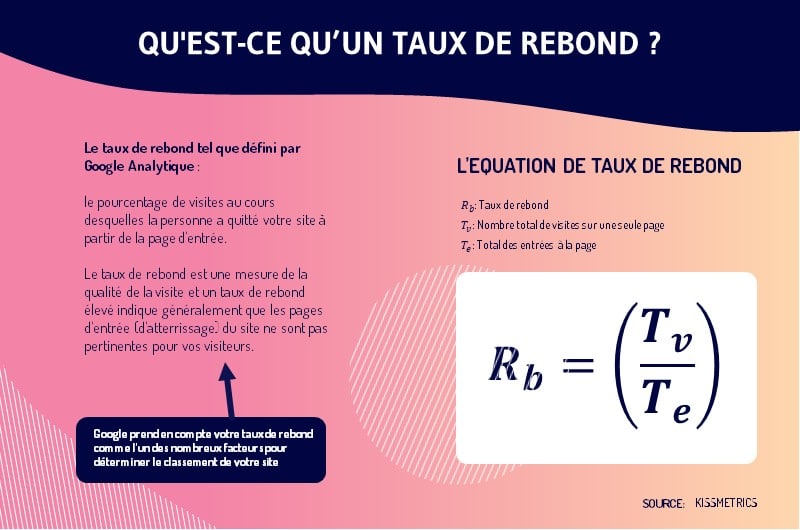
To be more explicit: The number of visitors who leave a website after only visiting the landing page (the page that led them to the website) and do not interact in any way, divided by the total number of visitors to the site.
Suppose for example that you have a total of 1000 visits to your site and that 400 of them have bounced:
400 (Number of bounces) / 1000(Total number of visits) = 0.4 = 40% (Bounce rate)
According to the calculation, your bounce rate would be 40%.
Please note that Google Analytics does not specify the number of bounces on your website, but you can easily perform mathematical operations and get the exact number of bounces.
However, the most valuable metric is bounce rate, as it usually has a significant impact on your SEO and digital marketing.
1.3. Why should you care about your bounce rate?
As mentioned in the introduction of the article, your bounce rate is a key indicator of your success in digital marketing, especially when you are in sectors like e-commerce.
Why is that ?
Well, you can drive a ton of traffic to your site, but if those visitors aren’t engaging or viewing other key pages (sales or products), what’s the point? Not much.
In other words, a bounced visitor does not convert, whereas the main goal of most websites is to convert visitors.
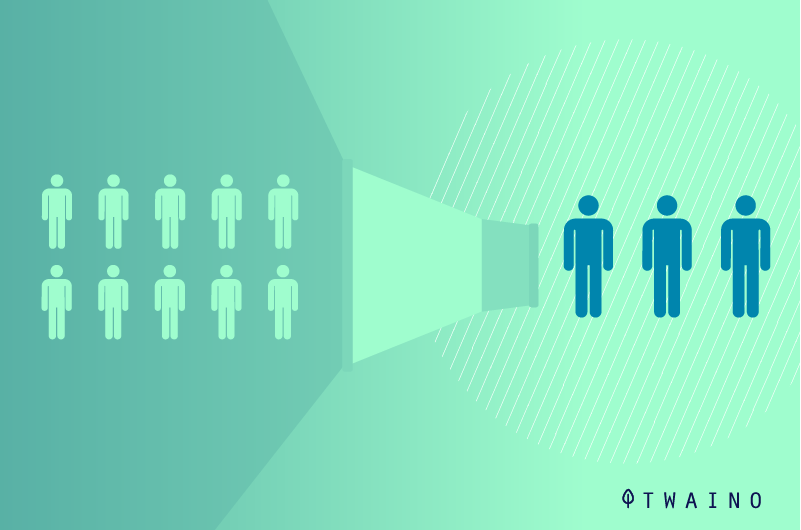
For example, if a visitor lands on one of your blog posts, but doesn’t sign up for your newsletter and visit your other pages such as your sales page, there’s no conversion. Result, no information on the prospect and no sale.
A high bounce rate may therefore indicate that you are attracting low-quality traffic.
To identify the exact problem, you need to check your traffic sources (PPC, SEO, social media, etc.) and your audience reports. However, the problem may not be with your visitors, but rather with your website.
If they don’t see what they want on your site, they will probably bounce back! This can happen because your landing page is not relevant to these visitors.
You can’t blame a bouncing visitor when they land on your site looking forcar insurance and in your article you talk about car loan rates.
The same thing happens if you misalign your content with user intent. Be sure to expect high bounce rates, if users are simply looking for informative content on your site, but are immediately loaded with sales pitches.
Similarly, poor user experience such as slow loading speeds can also cause many people to bounce back. No one wants to wait more than a split second for your site to load.
In all, a high bounce rate can have an impact on your SEO:
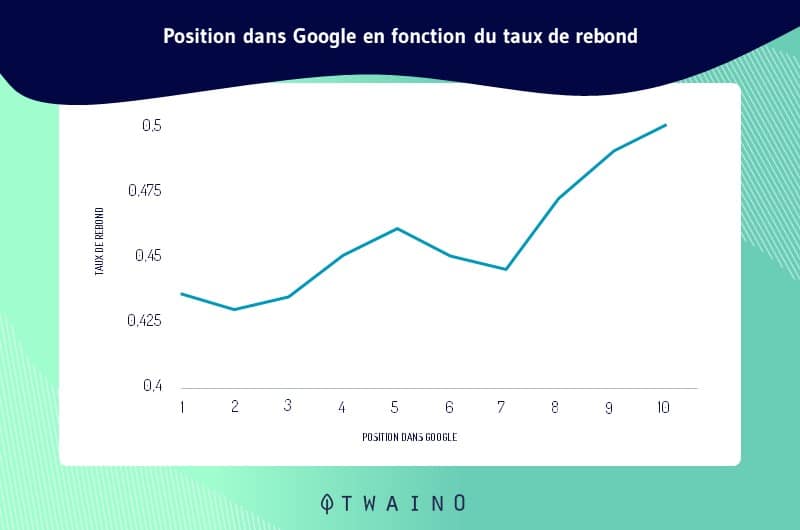
Although not confirmed as one of Google’s ranking factors, there is a strong correlation between your bounce rate and your ranking.
Pages with relatively lower bounce rates tend to rank higher in Google’s search results.
This is understandable given that bounce rate is a component of visitor dwell time, which has a major impact on your SEO.
Thus, your bounce rate is a good indicator of the effectiveness of your marketing, as it can impact conversions as well as your organic position.
The next logical question is: “What is a good bounce rate?”
Chapter 2: How to recognize the right bounce rate for your page or website in general?
Now that you know better about bounce rates, let’s see how to recognize the right one for your site.

But before judging the rate appropriate bounce for a web page, you must first define its purpose.
2.1. Consider the Purpose of the Page
It’s also important to know thata high bounce rate isn’t always bad, as not all content serves the same purpose.
For example, some content is designed to sell a product or service, while other content is simply there to provide information.
Therefore, different types of content are likely to have different goals or purposes.
Let’s look at an example:
The goal of content that sells a product is to move the visitor along the sales funnel, either to make a buying decision or to demonstrate their desire to buy.
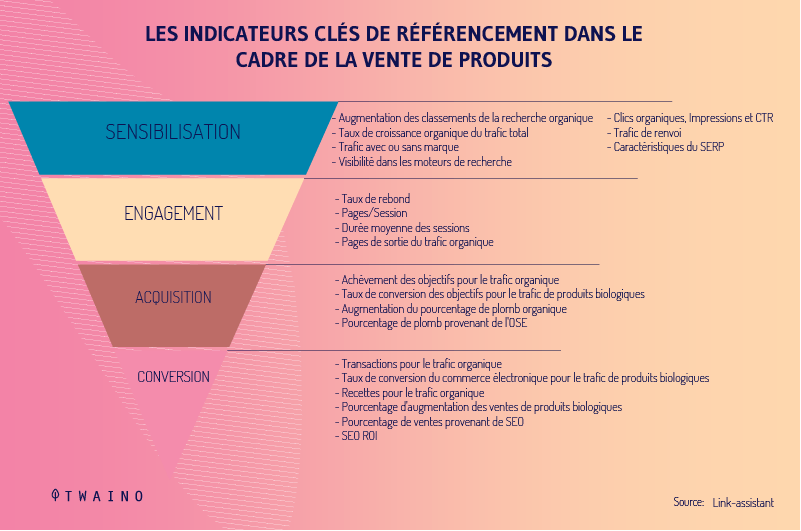
A conversion may include adding the product to their cart or filling out a contact form. In this case, a high bounce rate would not be preferable, because a bounce would represent a potentially lost customer.
Even if they haven’t added anything to the cart or filled out a contact form, your goal would be to see them navigate to other areas of the site, like a different product category. In such a case, a high bounce rate would be a problem for the page.
But what if the page was purely informational ?
Take this page as an example. We created it to provide our website traffic with a reliable, high-quality source of information about SEO terminology and specifically bounce rates.
Will it convert traffic into customers? Maybe, but that’s not the purpose of the page.
It is a source of information for visitors, a potential link-building resource for us, and content that will help us establish ourselves as an authority on the subject.
Therefore, we wouldn’t be surprised if this page gets a high bounce percentage. After all, if a visitor is looking for information on bounce rates, they may not be looking for anything else.
Hopefully, when they stumble upon this page, they find all the information they need and bounce back as happy users.
This type of content with a high bounce rate only becomes a problem when users return to the search results page and click on additional results.
This would tell Google that your page did not provide the correct information and the user will continue searching for an appropriate answer on the results page.
The best way to remedy this is to ensure that your information pages with high bounce rates are the best they can be.
In short, before knowing the average bounce rate for your page or site, you must first define its objective.
After defining the purpose of your page, now proceed to identify the appropriate bounce rate for your site.
2.2. Identifying the Right Bounce Rate for Your Page/Site
It’s hard to accurately interpret percentages and avoid common analytic mistakes. The more popular a website is, the more diverse the traffic received and the more likely visitors are to bounce back.
Some may leave immediately upon landing on a website because they finally realized they were in the wrong place.
On the other hand, a high bounce rate is desirable when visitors have a satisfying experience.
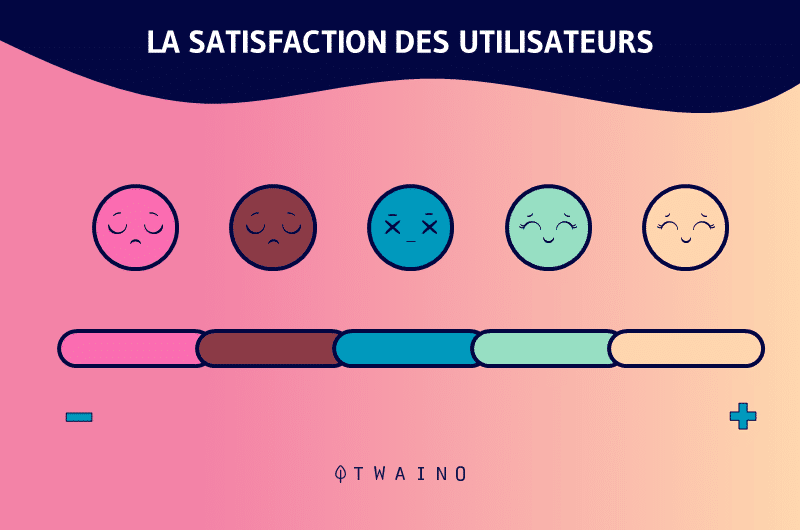
One of the most common scenarios is when we see a high bounce rate on a portal’s homepage and rush to judge it has poor performance or low quality content.
In fact, you don’t need to improve anything on this level because visitors tend to consume news and then leave on a news-related website.
Another good example of an acceptable high bounce rate is outbound link clicks.
When visitors go to a website and click on an external link inside the page, it can be considered a bounce, but it is a positive interaction if that link redirects to a relevant website.
According to many Google Analytics experts, the bounce rate percentage above 35% is concerning and anything above 50% is concerning.
However, avoid judgment until you assess some crucial factors, such as:
- Brand credibility
- Type of website
- Type and placement of web page within the site
- Visitor intent and level of their life cycle.
Now let’s start with the real stuff:
2.2.1. Behaviors Recorded as Bounce by Google Analytics
There are five typical visitor behaviors that determine the bounce rate of a web page:
- Visitors press the browser’s back arrow.
- Visitors type a new URL in the address bar and press Enter.
- Visitors close the browser window or tab.
- Visitors remain inactive for more than 30 minutes and session times out: Any further interaction after this time, even if it occurs within the site, is considered a new session.
- Visitors click on an outbound link, that is, a link to another website.
2.2.2. Average bounce rates by industry and website type
Average bounce rates may vary depending on the industry you are in:
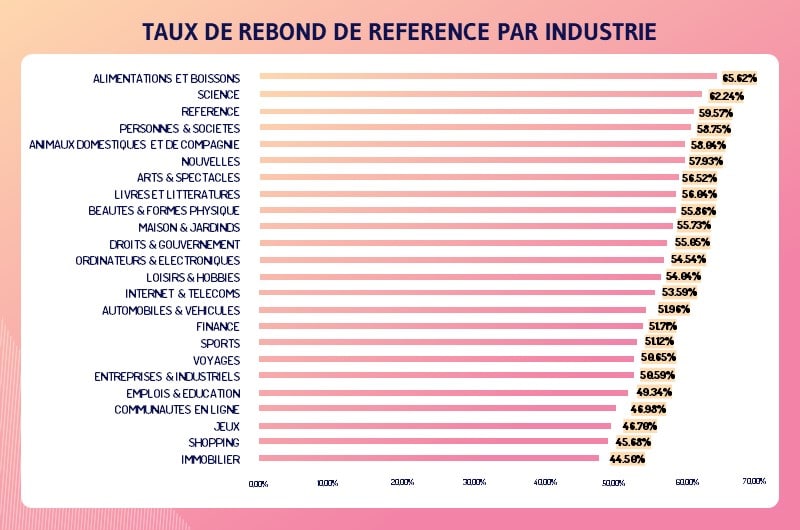
Here are the ratesaverage bounce rates for some of the most common types of websites:
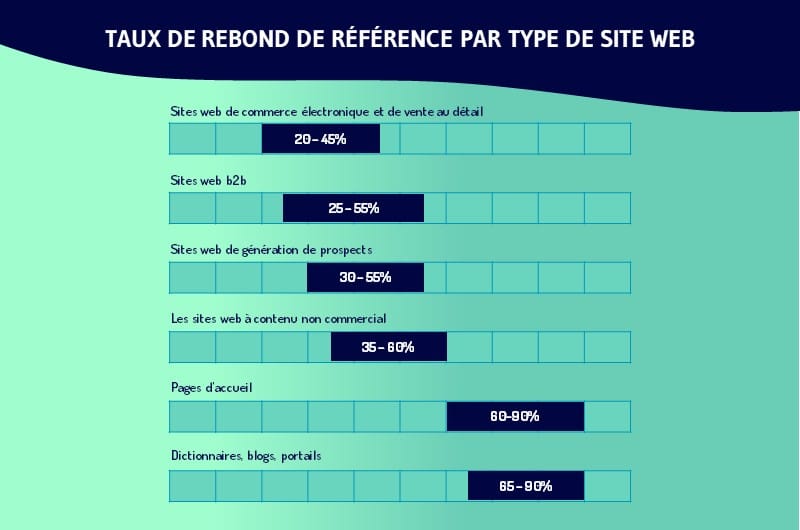
2.2.3. Types of Web Pages with Reasonably High Bounce Rates
Here are the most common types of web pages with reasonably high bounce rates:
- Blog posts often have a bounce rate of 65% or higher. Typically, visitors disappear after finding the valuable and relevant information that brought them to the page.
- ‘Contact Us’ are a known and accepted type of page for a consistently high bounce rate, as visitors just need basic information like a phone number, email or address and leave immediately. .
- . Form submission pages typically have high bounce rates since the goal of visitors is to simply complete the submission process and bounce right back
- Confirmation pages most often represent the final step for visitors, so the upside of the bounce cannot be avoided.
- Checkout pages are not a desired landing page and inbound traffic to these pages is often low. It is therefore not a concern that the corresponding bounce rate is high.
2.3. What exactly is the normal bounce rate for your website?
There is no universal threshold, but what you need to do is compare your bounce rate to other authoritative websites in your industry.
You need to act immediately if your visitors are regularly bouncing where they shouldn’t. Find the source of the problem and solve it with solutions listed in this guide.
Even if there is no universal threshold, beware of extremely low bounce rates.
For example, a bounce rate lower than 20% can be the cause of a bad configuration of your Google analytics.
In fact, a poorly configured Google Analytics can throw your numbers upside down and prevent you from seeing a realistic picture of your performance.
Check if your bounce rate is up to your industry standards by comparing it with that of similar type websites and draw some good conclusions.
Generally, a bounce rate starting from:
- 26 to 40% is excellent ;
- 41-55% is about average ;
- 56-70% is above average, but may not be alarming according to the website.
Once you have defined what you consider the normal bounce rate for your website, the next step is to understand where to find the data.
Fortunately, the data is very easy to find and understand in Google Analytics. The latter also provides other data to help understand the performance of a website.
This leads us to the next chapter:
Chapter 3: How to analyze the bounce rate of your page/site in Google Analytics?
When it comes to measuring a bounce rate, Google Analytics remains the best option. With this tool, you can monitor the overall bounce rate for your entire site, as well as for each individual page.
However, you need to dig deeper to diagnose exactly what is causing your visitors to bounce. That’s why you should look at your bounce rate from different angles, such as tracking bounce rate:
- Overall;
- For each marketing channel;
- By Source/Medium;
- By browser and operating system;
- On different devices;
- By geographical area;
- By age group;
- For each sex;
- By new and old visitors;
- By landing pages;
- With the flow of behavior.
Not being particularly familiar with Google Analytics shouldn’t be a barrier, as it becomes pretty self-explanatory once you understand the data and its purpose.
Now, let’s go into more detail by going through the top 11 areas you need to check:
3.1. Inspect your overall bounce rate
The best way to start is to assess your overall bounce rate.overviewaudience and you’ll see your site’s bounce rate along with other key metrics.
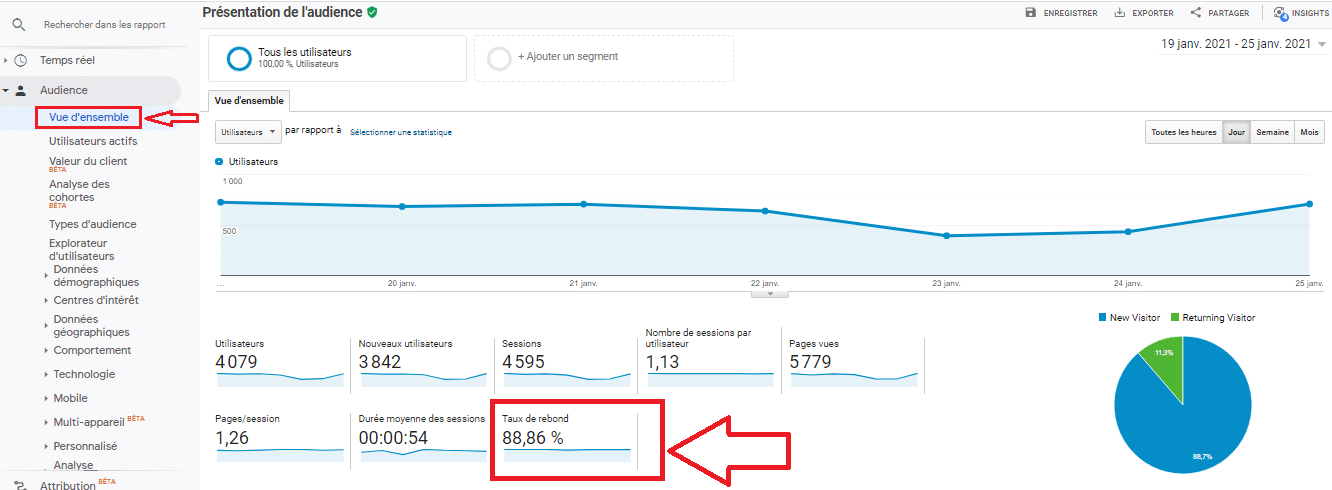
You can also compare bounce rates over different time periods. Simply select the time periods you want to compare and see how your performance changes over time.
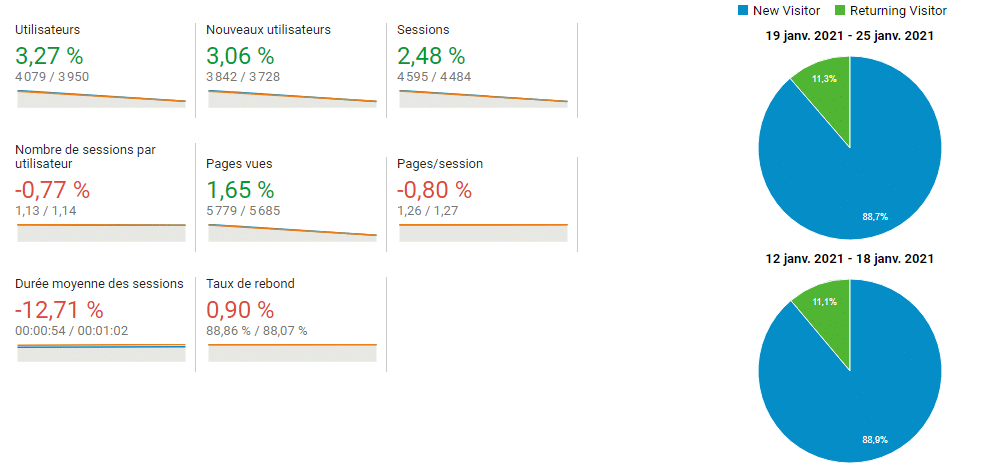
This is especially useful if you’re making significant changes to your site or content and want to measure how it affects your bounce rates.
If you find that your overall bounce rate is too high, you should investigate further to see if the problem is general or ifthere is a particularly problematic section that needs to be fixed.
Inspect other specific areas, such as your channels, traffic sources, audience, and even individual pages for a more comprehensive analysis. This will help you troubleshoot and correct the problem.
3.2. Check the bounce rate for each marketing channel
The next place to check is youracquisition where you can analyze the bounce rate for each marketing channel.

This report will show you which marketing channel is driving the traffic of the highest quality.traffic Social has the lowest bounce rate of 50%, which means that visitors from this channel normally respond to our content.
traffic Direct has the highest bounce rate (91.80%), which means there might be something wrong with targeting. In this case, you need to find out what is wrong with this point.
Here is an overview of the average bounce rate per channel:
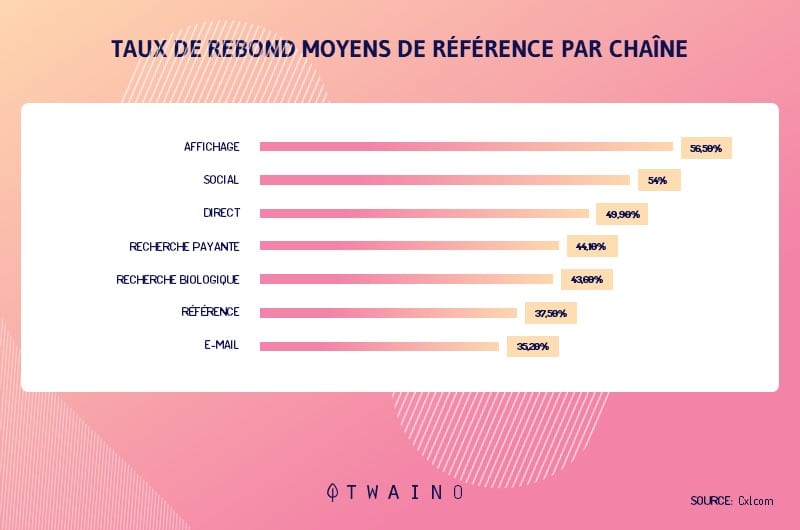
3.3.Tracking by Source/Medium
Under the main ‘Audiences‘ category, you’ll see ‘Acquisition‘. By clicking in this drop-down menu, you will see “All traffic“, then “Source/Medium“:
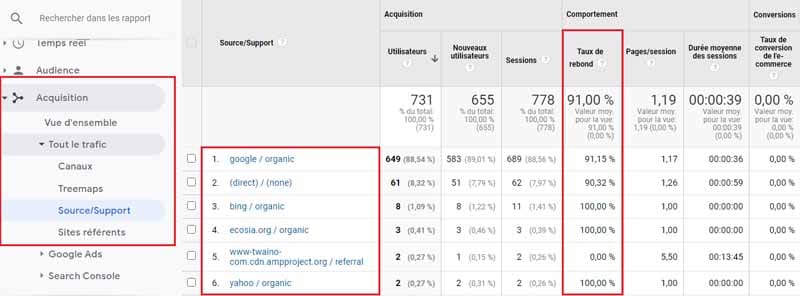
This report shows you how traffic is distributed between different inbound sources, such as Google, Facebook, Instagram, Bing and any other sources, media or channels you use.
You can learn a lot from this report. Here’s a quick overview:
- Find out where all your traffic is coming from and how effective each channel is at attracting new visitors.
- Measure how engaged audiences in each channel are based on bounce rates.
- Compare bounce rates across channels and mediums to see how each audience is engaging.
- Find ways to better align marketing channels and website experience.
3.4. Monitor your bounce rate by browser and operating system
tab Technology menu category Audiences , you can choose to segment your traffic report by type of browser and operating system.
This shows how each browser/operating system (Chrome, Safari, Firefox, Android and others) affects traffic and bounces.
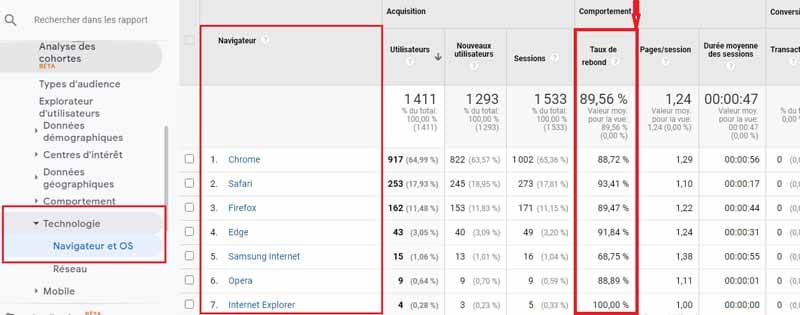
This is a good option to check out from from time to time. If there is a browser with a significantly higher bounce rate, it may indicate that your website is not performing well for that browser preview.
You may need to reconfigure some options so that these users have the same frictionless experience as other types of browsers.
That said, this report can be misleading if you’re not careful. On the one hand, some browsers and operating systems are not very popular.
A high bounce rate for a type of browser is not alarming if only 5 people use it to connect to your site.
It is also important to look at different versions of each operating system/browser.
For example, bounce rates can change significantly between Internet Explorer version 8.0, 9.0, and 10.0. Some outdated versions are still widely used.
You may need to fix the errors these users encounter if they represent a significant portion of your audience.
3.5. Monitor your bounce rate across different devices
Google Analytics lets you monitor your performance based on the technology your visitors are using. This means you can track bounce rate across different devices.
Go to your Audience and scroll down to the Mobile then Overview to analyze device performance:
- Computer
- Mobile
- Tablet
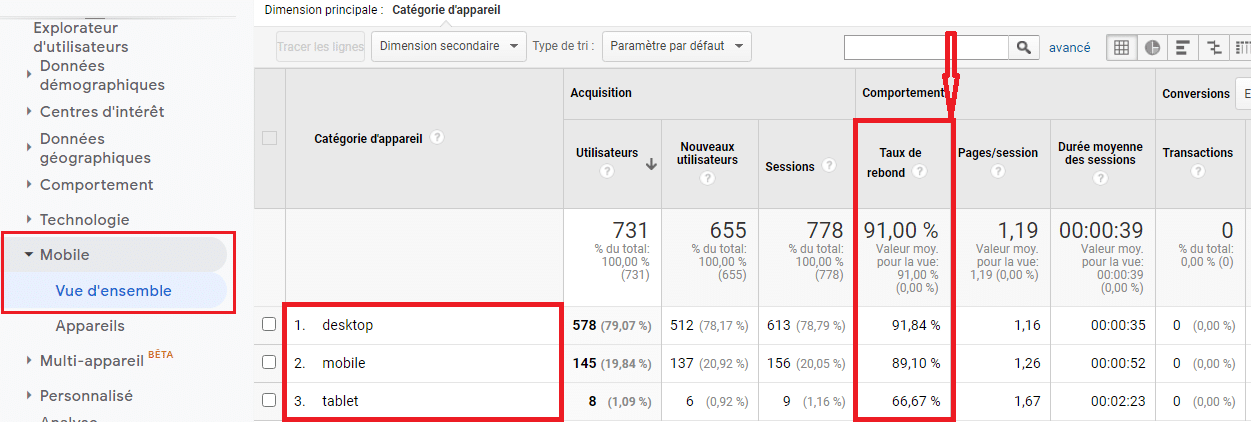
Again, you can use this overview to see the impact of different device types on bounce rates.
If you see a high bounce rate on some device, that can be a clear indicator of a poor user experience on that device.
Be very careful with mobile devices. If the bounce rate is much higher than on desktop, you need to optimize your site for mobile.
This is especially important because Google emphasizes mobile-first indexing, and poor optimization can hurt your SEO as well as your rankings.
3.6. Track Your Bounce Rate by Geography
Another key area you need to analyze is how different audiences react to your site and content.If you serve international audiences, go to the Audience and see the Geography > Geography section:
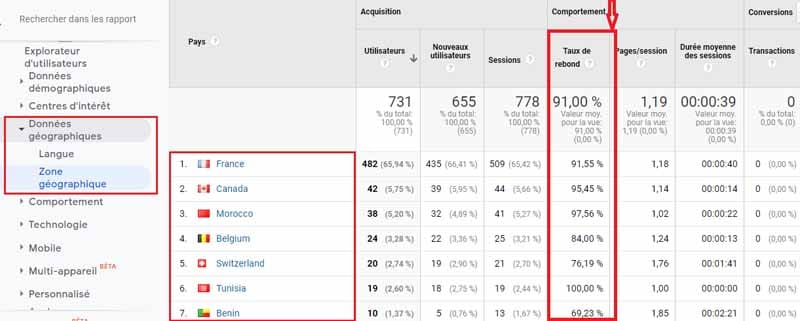
Here you will find the option to segment your traffic (and your bounce rate data) by country. This is extremely useful if you are running global campaigns and want to compare audiences across countries.
This can help you optimize your strategies by location.It’s also worth checking out the Language to check the bounce rates for each language.
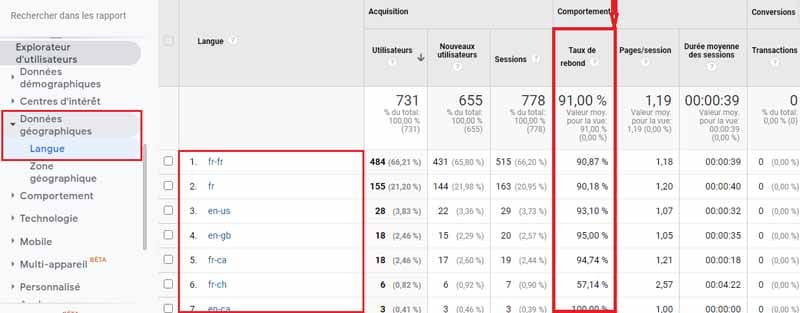
For example, if you don’t get enough engagement of your English-speaking audience, you may be able to improve their user experience by creating an English version of your site.
This can dramatically lower your bounce rates and increase conversion.
3.7. Bounce Rate Tracking by Age
Group Google Analytics tracks a lot of different demographics of your site visitors.
This is great because you can really get into the different audience segments and better understand your site traffic. The age range of your visitors is one such demographic.To see your bounce rate by age group, look under “Audience” on the left side. Then, search for “ Age ” in the “ Demographics ” category:
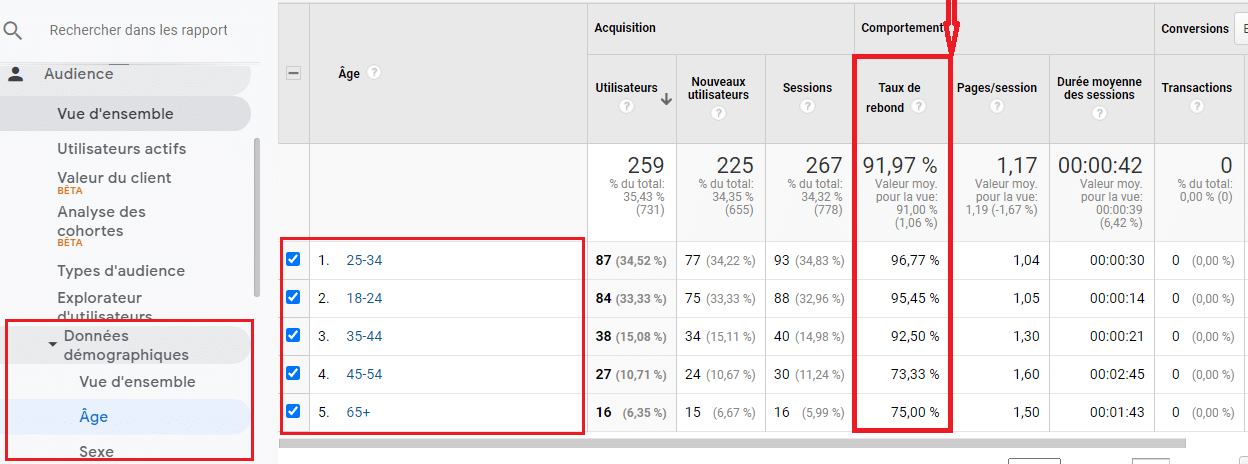
Now you can quickly see the impact of age brackets on your bounce rates. The latter can vary depending on the type of audience (young or old) you are targeting, because the expectations are different.
In some cases, you can develop pages specifically for different age groups.
3.8. Bounce rate tracking by gender
Under the same categories “ Audiences ” → “ Demographics ” in the left menu, you will find “ Gender option Age .
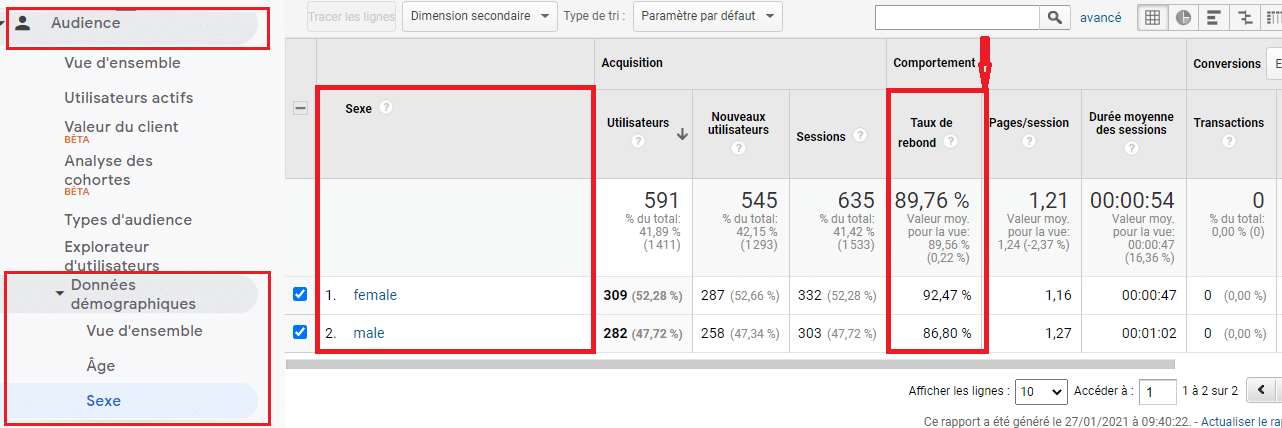
Similar to age demographics, this option will allow you to see whether your pages are more apt to engage a certain gender, whether male or female.
For businesses that cater to a specific gender, a high bounce rate for the opposite gender may not be an issue.
However, if you’re trying to appeal to both genders and one of them bounces around more often, your branding may give the impression that you’re a male- or female-oriented business.
3.9. Bounce rate tracking by new and returning visitors
Another useful segmentation method is ” optionVisitors new/known” under “Behaviors“. This is the “Audiences” category under “Geography“.

New visitors and repeat visitors tend to act differently.If bounce rates are very low for new users, this can be very telling as to the effectiveness of your inbound marketing strategies.
It doesn’t matter if returning visitors have a high bounce rate, as long as new users are engaging and exploring your site.
By looking at new and returning visitors, youwill have a better idea of how these two segments interact with your site and its content.
3.10 Bounce rate tracking by landing pages
Here you will be able to examine the performance of your main landing pages. Access the behavior and scroll to the Site Content> Landing Pages.
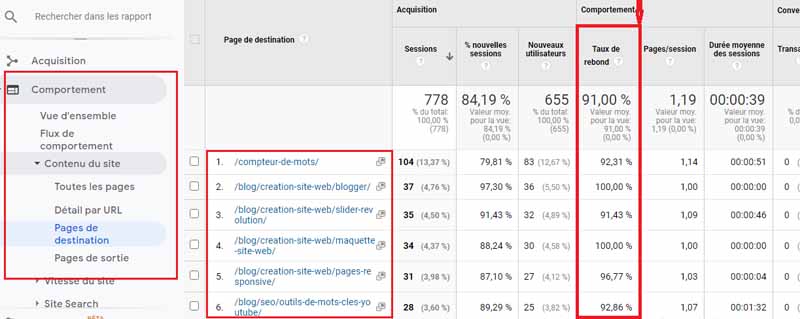
These pages are essential to your marketing success, especially if you have invested in PPC ads. This report will allow you to quickly identify the landing pages the least and the most engaging.
Both of these groups will be great learning lessons. You’ll be able to learn what works on some pages, what doesn’t work on others, and how to use both types of information to develop better experiences.
To determine what is preventing users from converting on your landing page, ask yourself the following questions:
- Is your landing page relevant?
- Is the user experience engaging?
- Do your CTAs stand out and are they compelling?
- What are the next steps you want users to take?
- Is it difficult to navigate to other pages on your site?
3.11. Bounce Rate Tracking with Behavior
Also check the ‘Behavior Feed’ to see which pages users go to after your landing page:
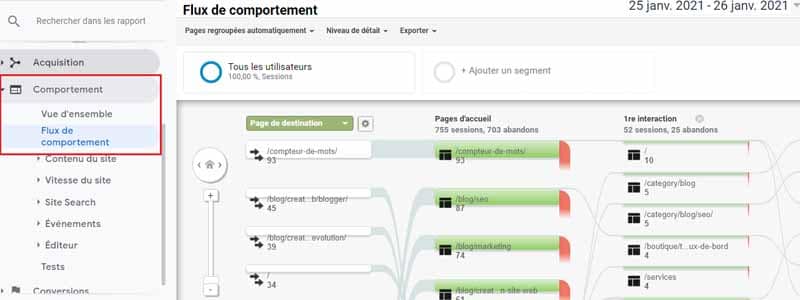
Check if visitors are going in the right direction and if these pages are optimized for conversions.
Once you’ve diagnosed the problem in Google Analytics, it’s time to take action and reduce your bounce rate.
Chapter 4: How to reduce your bounce rate?
Before giving you the tricks to reduce your bounce rate, I would like to present some main reasons why bounce rates are often high.
4.1. Reasons for High Bounce Rates
There are several reasons that may indicate increased bounce:
- The visitor did not find what they were looking for;
- The visitor has found what he was looking for, but unfortunately the offer does not meet his expectations (end of promotion, unexpected costs, registration form, etc.);
- The visitor found what they wanted, but didn’t want to buy (because your site is not user-friendly or has poor optimization for conversions).
Here are some bad practices that immediately drive visitors to the exit:
- Poor page design (heavy with text, unresponsive, poor contrast, poor choice of colors, fonts and other design elements);
- Disturbing navigation;
- Poor formatting: No bold, no italics, little or no spacing between lines and paragraphs;
- The site appears to be spam because there are too many advertisements or promotional offers;
- The page is taking too long to load;
- Misuse of titles and subtitles;
- Automatic playback of audio and video content;
- Etc.
4.2. 21 Tips to Reduce Your High Bounce
Rates A high bounce rate can potentially hurt your chances of success, so it’s essential that you analyze the different areas of your site and identify the cause of the problem.
Once you’ve identified the problem area, it’s time to take action and reduce your bounce rate.
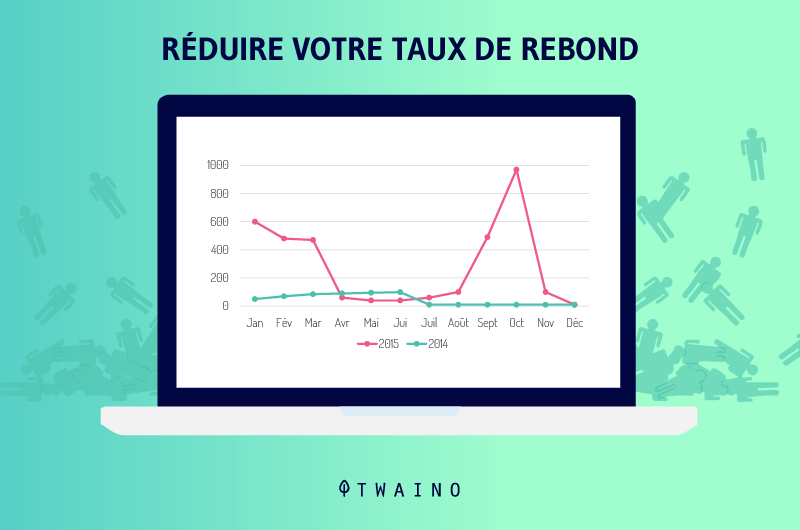
Below are 21 actionable ways to reduce your bounce rate and increase conversions.
4.2.1. Check if you have configured Google Analytics correctly
Before you do anything, check that your Google Analytics is correctly configured.
If you haven’t configured GA correctly, it may not be capturing bounced visits to your site, which can skew your results and give you a false reading of too low or too high a bounce rate.
You need to check these three points:
- Google Analytics tracking code
The first thing to check is whether you have correctly installed the Google Analytics tracking code. If you use WordPress, check your Google Analytics plugin.
You can use any plugin you like to integrate Google Analytics into your WordPress website.
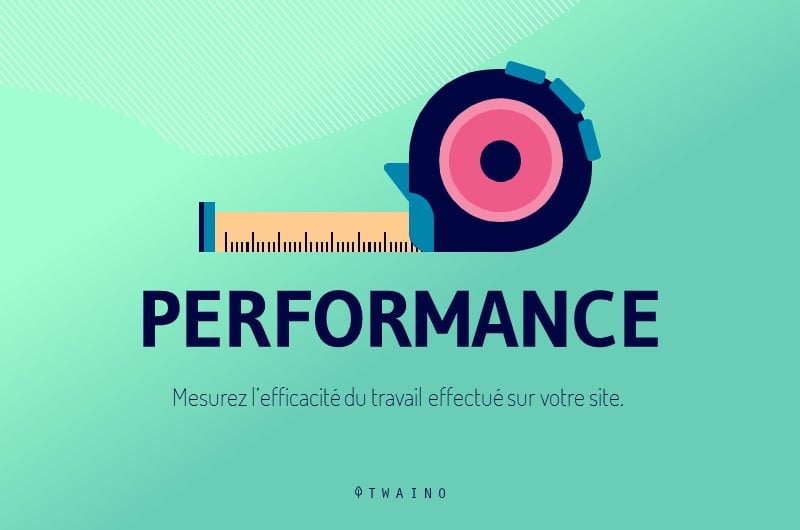
Then check in GA admin area if it is getting traffic from your tracking code. Send test traffic and check the real-time report to check if everything is OK.
It’s also worth checking that you don’t have duplicate GA tracking codes. So take a look at the plugins menu and make sure you only have one Google Analytics plugin installed.
Finally, check your Appearance> Editor in WP and make sure you only have one tracking code in the header.php file.
- Goals and Events
You may also have an important event that you want to track, such as a conversion (signup or email purchase).
If the goal is set up incorrectly, Google Analytics won’t be able to detect it and you’ll get higher bounce rates than you should. So check your goals to make sure GA is tracking all your important events.
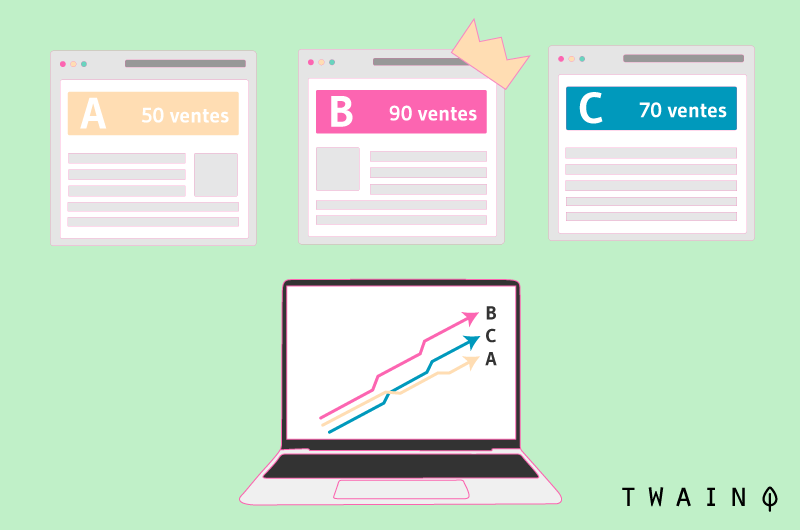
You can learn more about GA and how to set it up properly in our comprehensive Google Analytics guide .
- WordPress plugins
Finally, check your other plugins to make sure their operation doesn’t trigger Google Analytics.
For example, a chatbox plugin (although useful) might open on its own once a visitor lands on the page, which could trick GA into thinking there was user interaction.
This can skew your bounce rate and you’ll see numbers that are significantly lower than they might actually be.
4.2.2. Improve the readability of your content
A very common reason why your visitors may bounce is the lack of readability of your content.
It’s all about how people consume content these days: They don’t read, they skim.
If you have large blocks of text, it would be difficult for users to take a look and see if it’s something they would like to learn more about. Do not publish articles that look like a novel, it becomes boring very quickly.
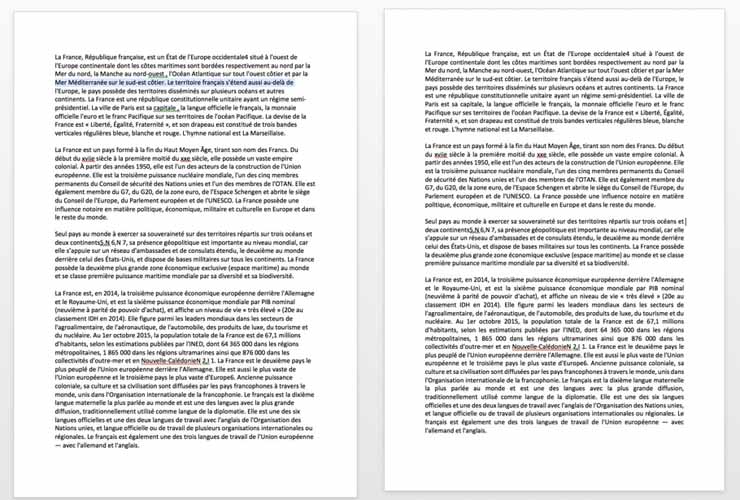
Source : CIG
Your visitors will quickly lose their focus and attention and move on to other things that are more important to them. For your site, this translates to a bounced session and no conversions.
Instead, post content with readability in mind, allowing users to scan articles and extract the most important bits in seconds.
You can take the example of this content that you read.
Here are six (06) tips for creating content in an easy-to-read format to reduce your bounce rates:
- Use subheadings to separate different sections of your article;
- Write short paragraphs (3 lines at most), concise and precise;
- Include bullet points to explain steps, benefits, or important points;
- Break up your text with custom images, graphics, and screenshots;
- Use examples to explain difficult concepts;
- Insert a (clickable) table of contents at the beginning to allow users to jump to the desired section.
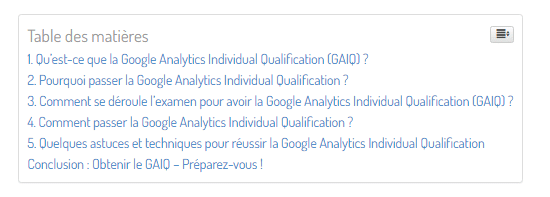
Don’t forget to ask an engaging question at the end of the article to invite users to comment and share.You can improve the readability of your content using theReadability Analysis Yoast SEO plugin
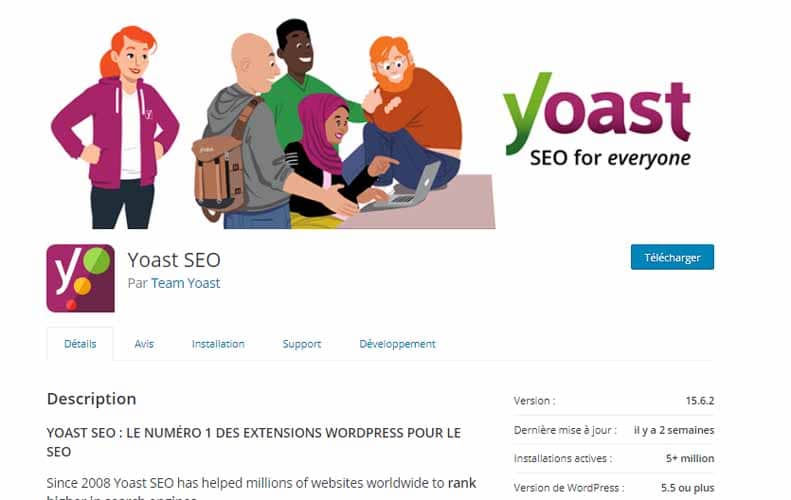
I created a guide on 10 tips for creating content that will grab the attention of visitors and encourage them to share, you can consult.
4.2.intent
– pop-ups Pop-ups are a conversion optimization very effectiveThey are one of the essential elements for an email list building strategy.

However, relying too much on this tactic can have negative implications. Too many popups can disrupt the user experience.
The end result is users bouncing back. Most of them don’t want to deal with distracting popups. This is especially true for popups that take up the entire screen.
Also, if it’s too hard to close the popup, users will be more likely to bounce back.
The same is true if you use aggressive (bully) language.
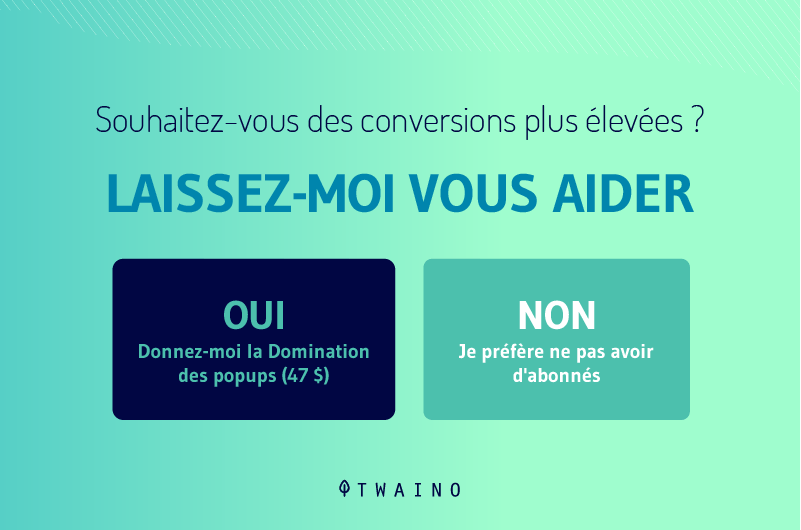
Yet effective lead generation relies heavily on the use of forms contextual. However, make sure they are not disturbing.
In fact, I argue for using exit intent popups that appear as soon as the user is about to click the exit button.
Many plugins like Optin Monster allow you to add exit intent popup forms.
Without forgetting, above all, avoid popups that force you to accept cookie policies as soon as the user lands on your site.
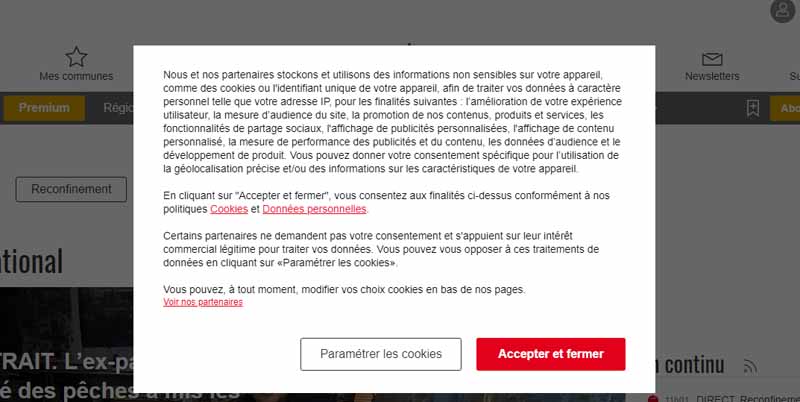
4.2.4. Have Compelling and Relevant CTAs
Every page on your site needs a clear and compelling call to action! Whether it’s your homepage, landing page, or product page, you need to tell visitors what you want them to do next.
However, the actual statistics are shocking. 70% of SMB websites don’t have a call to action. And that’s one of the main reasons why many small business websites have high bounce rates.
To reduce your bounce rate and increase your conversions, you need a clear and easy-to-spot CTA on your site in 3 seconds or less.
Instead of leaving your visitor to guess what to do next (and bounce back), invite them to take action with one clear CTA.
This can be a CTA to your newsletter:

Here are some tips to follow when adding your CTA:
- Stand out – Use contrasting colors and bold text.
- Be relevant – Your CTA should be closely related to the content your reader is consuming. For example, links to content that offers more information on the subject he is reading would be perfect.
- Be clear – Tell users exactly what will happen once they click the button (get a quote now, sign up, etc.).
- Use commanding words – Be confident and tell users what to do
Also, don’t confuse your visitors with multiple (different) CTAs on one page. In fact, users may be confused by a large number of call-to-action options on a single page. Result, they are likely not to click on any of them (another bounce).
4.2.5. Attract the Right Audience with Target Keywords
One of the main reasons your bounce rate is too high is that you may not be targeting the right audience.
You might get a ton of visitors, but if the traffic is low quality, you won’t get a lot of engagements let alone conversions.
This is why your bounce rate is a useful signal that can indicate whether your targeting is good or not.
Even if you have the best content and the best user experience, if you target the wrong type of people, you won’t get a positive result.You need to target high-quality traffic, and that can only be done with high-value keywords. Find keywords that your ideal audience uses to search the web.
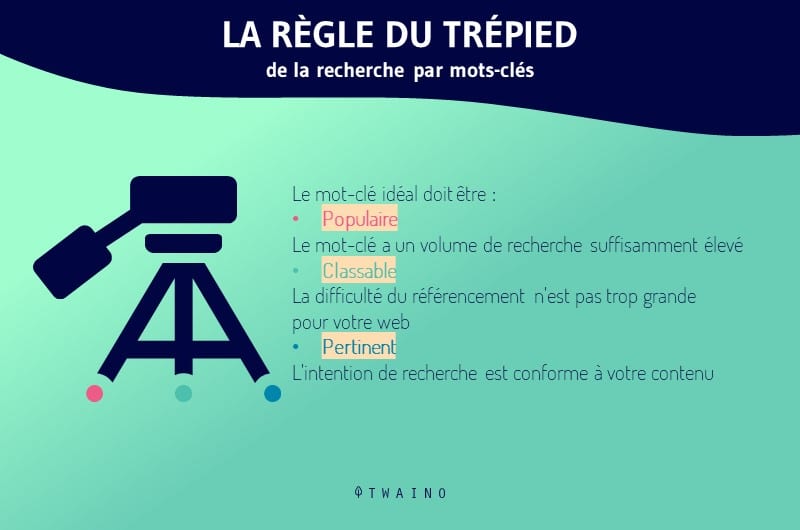
The most profitable keywords have traffic potential high and a transactional intention of the user.
You can learn how to find the most profitable keywords with our ultimate guide to keyword research.
High-value keywords will create detailed content and powerful pages that your visitors will spend more time reading. And the longer they linger on your page, the more trust you build and the more likely they are to convert.
But creating compelling content around quality keywords will also attract more backlinks and increase your site authority.
In short, choose high-value keywords to create your content and you’ll have a better chance of attracting the right kind of visitors. The latter are people who are interested and likely to convert in the future.
As a bonus, I’ve created a list of 21 best keyword research tools that can help you.
4.2.6. Create relevant content by focusing on user intent
Your pages and content should be highly relevant to the queries that brought users to your site in the first place. In the absence of relevant content, users will have no choice but to bounce.
For example, there is a lack of relevance when the visitor expects to read a “cottage cheese recipe” while your page presents “fried cheese”.
Even though these topics may be related in some way, you haven’t met users’ expectations and it won’t take long for them to leave your site.
Another cause of high bounce rates is not understanding user intent. Internet users are looking for different types of content depending on their situation. There are four distinct types of user search intent:
- Information
- Navigation
- Transaction
- Commercial search
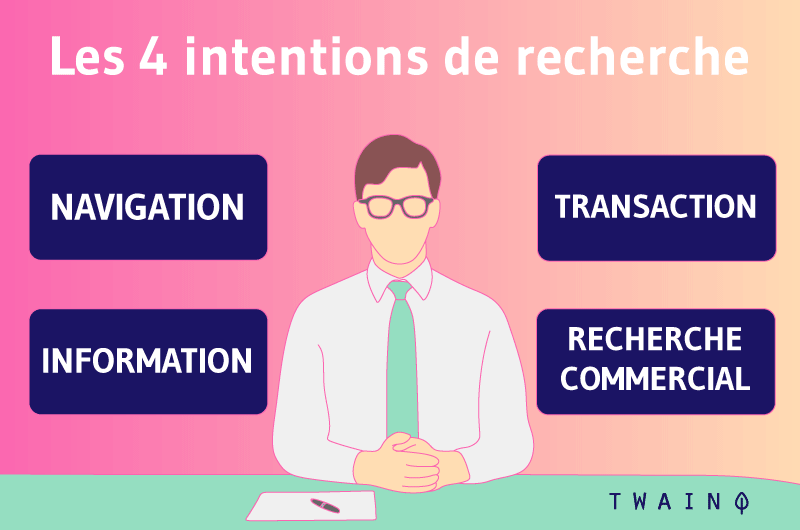
To reduce bounce rates, be sure to target user intent with relevant content.
If users are in the awareness stage, looking for content like how-to guides, create super-relevant informative content.
If you try to present your products/services at this stage with commercial or transactional content, you will only increase your bounce rate.
Last but not least, don’t try to fool your audience with baiting headlines. Gone are the days when fake content worked.
These days, bait titles that give false promises about the main content of the page are likely to get you:
- A high bounce rate;
- A low visit time;
- A downgrade in search rankings.
4.2.7. Optimize your site for mobile
Mobile traffic is very important these days. In fact, over 57% of all internet traffic comes from mobile devices. And these numbers continue to rise.
If you detect a high bounce rate in GA from mobile users, this may indicate that your site is not mobile friendly. To confirm that this is the problem, use Google’s Mobile Optimization Testing :
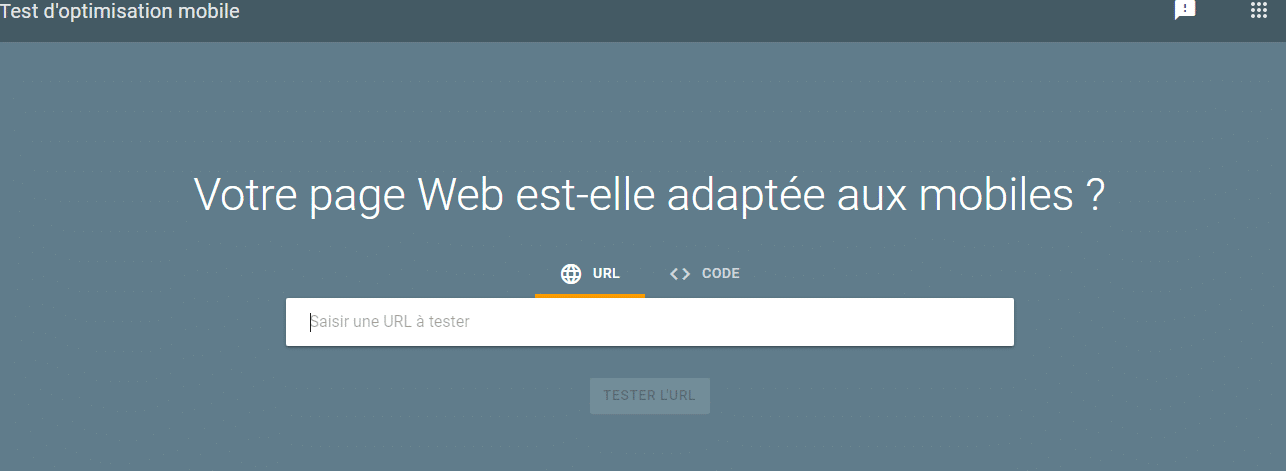
If your website is not mobile-friendly, you need to optimize it for them. Luckily, if you’re a WordPress user, it’s not that hard to do. Make sure you are using a responsive WP theme first.
Then consider using AMP (Accelerate Mobile Page), which means “ accelerated mobile pages and can significantly improve your performance on smartphones.
There are several other WordPress plugins that can improve your users’ mobile experience, such as:
To further reduce your bounce rate, use BrowserStack to see if your site is compatible with all common browsers that your visitors use.
4.2.8.loading speed of your page
the loading speed of your site is more important than ever.
Here are some statistics that demonstrate this:
- Consumer Expectations
47% of consumers expect a web page to load in 2 seconds or less:
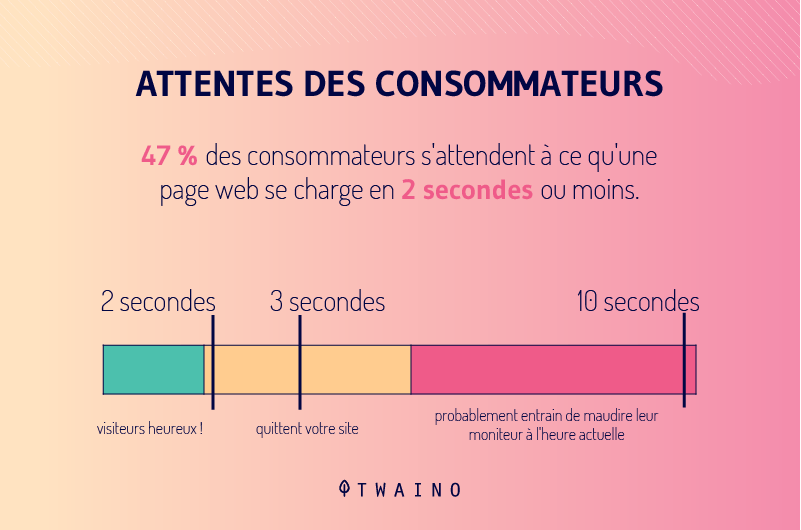
- Abandonment rate
40% of visitors will abandon a website that takes longer than 3 seconds to load:
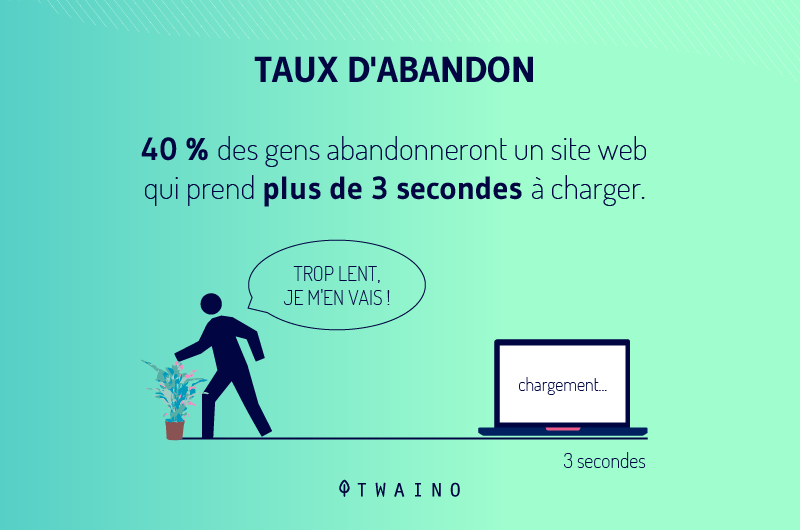
- Mobile
visitors 53% of mobile website visitors leave a page that takes more than 3 seconds to load.Basically, the longer visitors have to wait for your page to load, the more likely they are to bounce and the more conversions you lose.
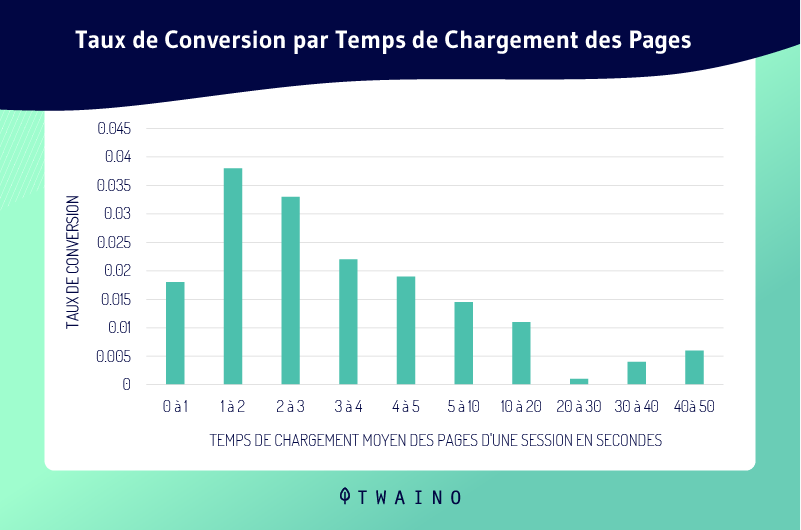
And more seriously, Google is also pushing low performing websites to the bottom of search rankings.
Since loading speed is critical to user experience, Google uses it as one of the leading signals.
In short, slower page load speed means higher bounce rate:
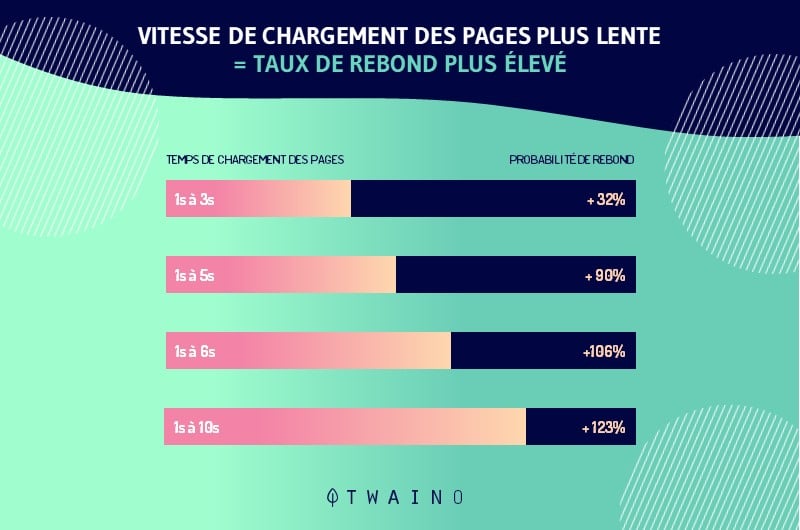
So be sure to check your site speed using free tools like Page Speed Insights and GTMetrix.
To reduce loading time, consider factors such as:
- The type of files you include on your site
- Compressing the files on your page if necessary
- Your JavaScript and check if it slows down the page
Speed optimization is a subject that deserves its own guide. In our speed optimization guide , you can learn how to load your site in under a second.
Optimize your site speed even if you have a low bounce rate. A fast website can only help you.
4.2.9. Make sure your page has been optimized for different audiences
If you serve an international audience, having your site in one language may not be enough. You need to ensure that the content has been translated correctly and is ready for users in different countries.
Despite the great popularity of French, there are still many who find it difficult to use it. Additionally, some might prefer to have a localized version of your website in their native language.
For example, Canadians have two official languages, English and French. If you want to target the whole population, you better have a website version for these two languages.
Work with local translators to ensure content appears correctly and naturally to people reading in different locations.You can also use a WordPress plugin like WPML to improve the user experience and translate your site for a multilingual audience.
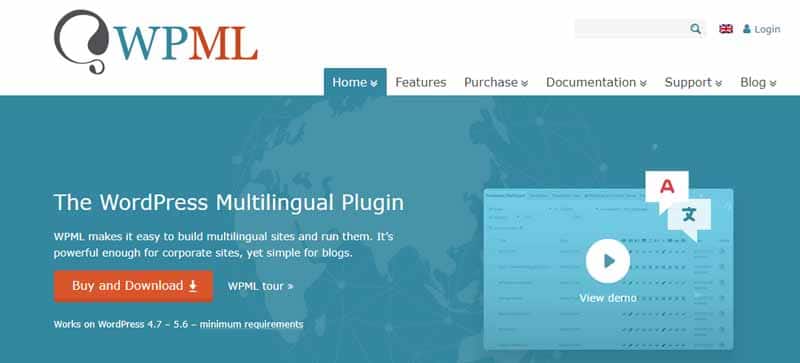
Offering your site in different languages based on user location is a surefire way to lower your traffic rate. bounce. When visitors see your site in the language of their choice, they’ll be more likely to stick around and even convert.
4.2.10. Optimize Your Internal Linking Structure
There are few better (and easier) ways to lower your bounce rate than using internal links. These structure your site and make it easier to link relevant content pages.
It’s so much easier for visitors to view more of your pages when you include internal links to relevant places in your content. Thus, users will no longer need to seek more information elsewhere, because everything is just a click away.
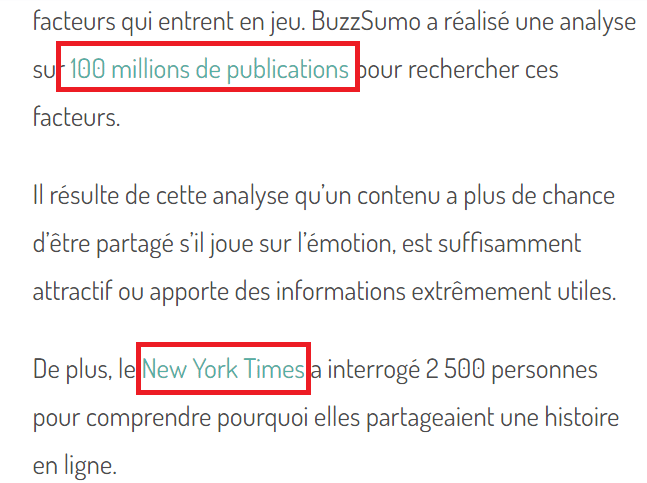
But internal linking doesn’t just reduce bounce rates. They will also help crawlers crawl and discover your pages to make your site more relevant. Additionally, internal links will help spread the “ link juice ” around your site to give you a powerful SEO boost.
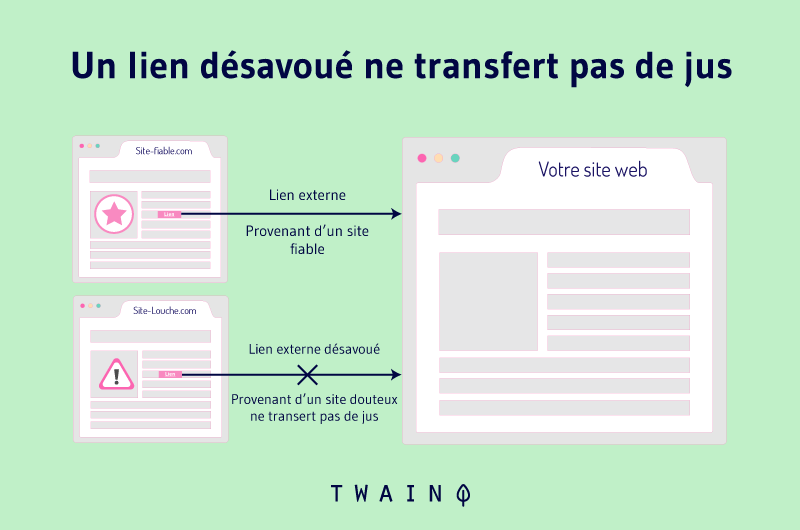
That doesn’t mean you should extend internal links just for pleasure. A link to content that gives more information on a particular topic or offers them more depth on that particular topic will work well.
Be careful to avoid linking to damaged pages such as orphan pages.
In short, don’t spam the reader with irrelevant content. It could cost you a lot. Instead, put internal links in your content only when it makes sense.
You can use Yoast SEO Premium to help you find related content on your site that you can link internally.
4.2.11. Make sure your external links open in a new tab
While we’re talking about links, another way to lower your bounce count is to open external links in a new tab.
Linking to external pages is often a good practice. However, for a good user experience, you should make its links open in a new tab.
Think of it like this: If a user clicks on an outbound link in your content, and then clicks a few more on the other pages, they will essentially be four steps away from your site. When the user decides to come back to your page, he will have to click four times on the ” back ” button.
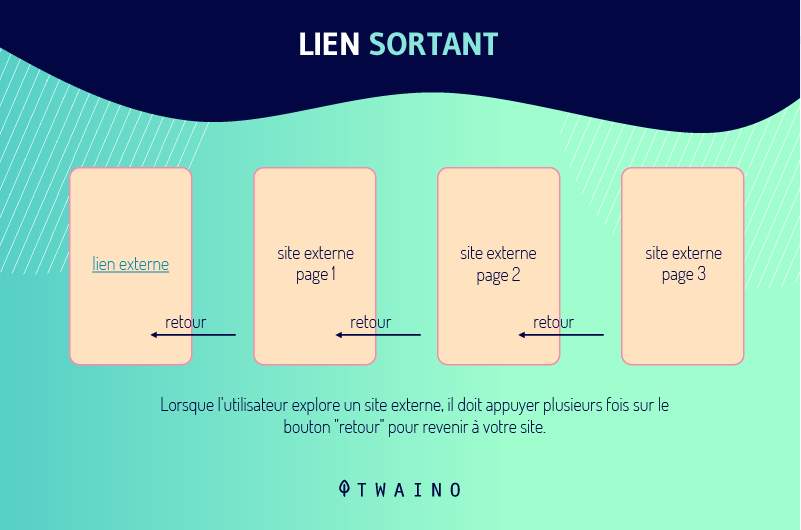
This leads to a phenomenon, aptly named, back button fatigue. This happens when users have to click the back button too many times. It gets so frustrating that users just decide to bounce back.
Sometimes, the user can even find something more interesting elsewhere, and:
- Either forget to come back to your site
- Or decide not to come back
Fortunately, you can easily define links to open in a new tab thanks to a plugin WordPress.
With a free plugin like WP External Links, you can configure all external links on your site to open in a new tab with just a few clicks.
4.2.12. Add Related Articles
Similar to the internal linking strategy, addingrelated articles can help lower your bounce rate. Related posts will make it easier for visitors to discover your content and browse more pages on your site.
There are many ways to do this. One of the most popular being to display related articles in your website’s sidebar widget.
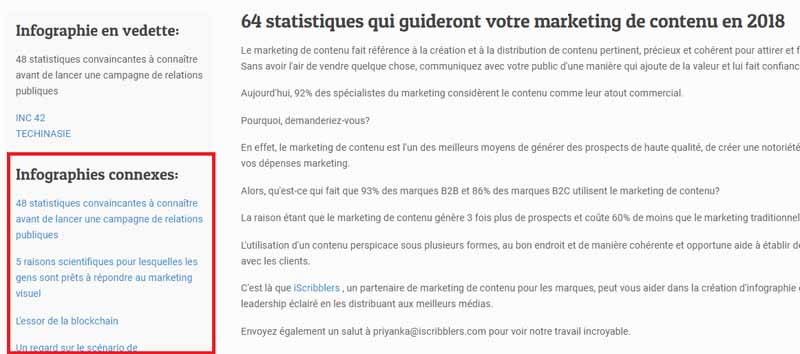
Another more effective method is to place suggested articles at the bottom of the main article, before the comment section. This makes sense because the user is more likely to search for related articles once they finish reading the first one.
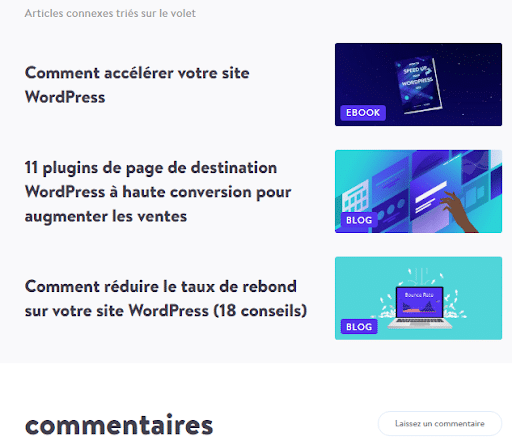
Placing related articles high up in the sidebar can be confusing. The user may be overwhelmed and confused if they are supposed to read this article or any other. This can potentially lead to a bounce of the visit.
But related content isn’t just for blogging. It also works well one-commerce.
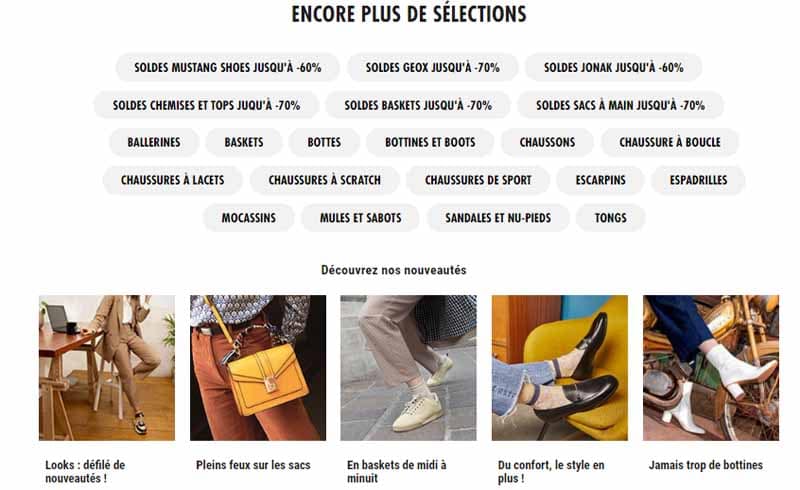
You can offer related and “frequently bought together” products to cross-sell or up-sell.
4.2.13. Be careful with ads, autoplay content, and other distractions
Many websites rely on ads for their revenue. Yet, intrusive and annoying ads can seriously disrupt user experience and increase your bounce rate.
According to a study, 65% of internet users block sites with too many ads in search results.
Also, the auto-playing audios and videos that come out of nowhere and appear in the corners of the screens are annoying.
4.2.14. Demonstrate credibility with trust and safety signals
Unless you’re on the top site rankings, not everyone knows about your business and brand.
To avoid bounces, add credibility to your site. Show that you are a legitimate business that people can trust.This is especially important for pages close to conversion stages, like your page sales or checkout. Include trustmarks and badges to lend credibility to your site.
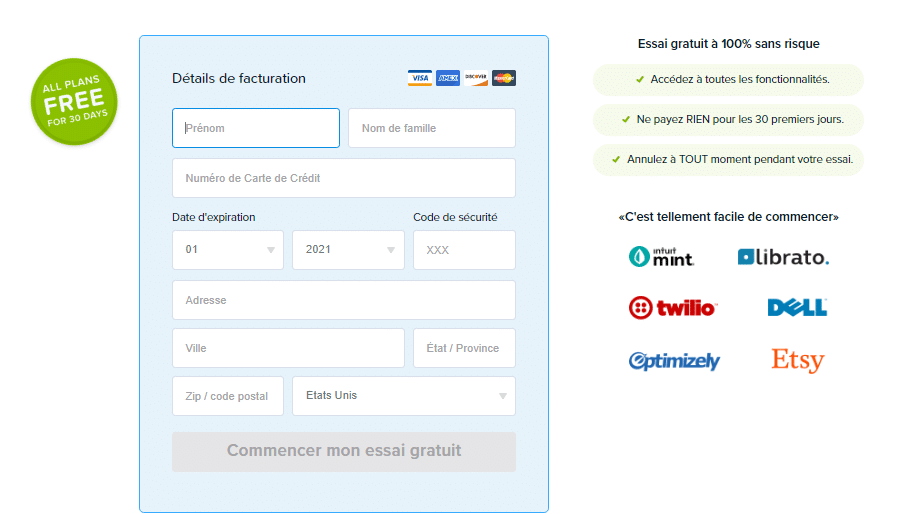
Trustworthy logos will help your visitors be sure they are making the right decision when buying from you and avoid unnecessary bounces.Another way to build credibility is to use an SSL certificate. This will help you badge HTTPS that appears next to your website URL.
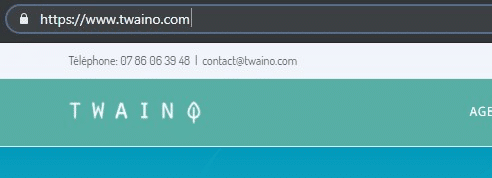
It indicates that all communication between your site and the user’s browser is encrypted, which means that it is secure.
So, make sure your hosting provider can connect you with one.
4.2.15. Make Your Site
Navigate Confusing navigation can be another reason why too many visitors are bouncing around and not checking out other pages on your site.
‘s navigation menus and CTAs are essential parts of optimizing your bounce rate. Menus will help users understand the structure of your site and where each section is located.

On the other hand, CTAs will indicate what to do next, i.e. what action the user should take next.
Normal navigation should point to the most important pages. It should reflect user behavior and make it easy for them to find the things they’re most likely to be looking for.
But that brings us back to the question, “How do I track user behavior to fine-tune my site’s navigation?”
To track user behavior, you can use heatmap tools such as:
- HotJar
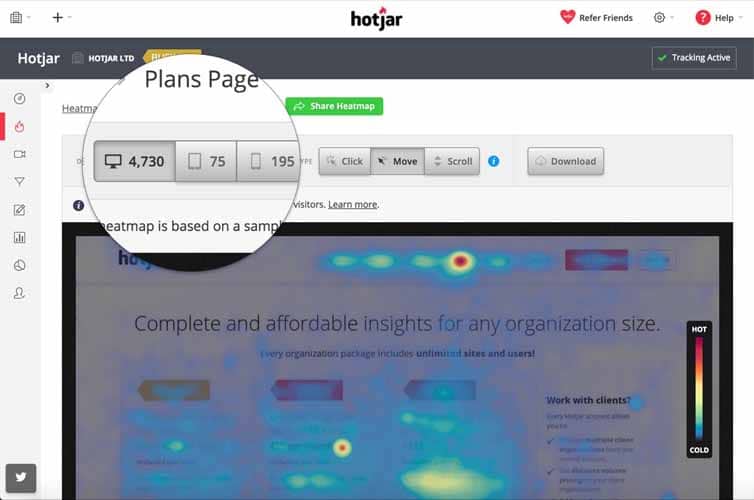
- CrazyEgg
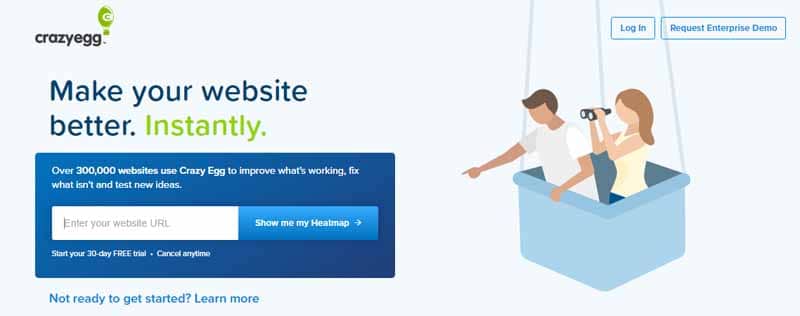
Find out:
- Which areas of your site get the most interaction
- Where people stop scrolling
- What the click-through rate is for specific elements of your site
Similarly, you can set up event tracking in Google Analytics for each element of your site.
This data will help you structure navigation intuitively and encourageusers to navigate further and visit more pages on your site. The simpler, the better.
4.2.16. Reduce
are Broken Links Broken links also signs that cause many visitors to stop browsing your site and bounce back.
If users can’t find what they’re looking for, it creates frustration and a poor experience. Generally, it ends with: An increase in the bounce rate and no conversion.
Over time, getting a few broken links is inevitable, especially if you have hundreds of posts and pages. However, you need to limit their number and improve your UX.
‘s crawl error report Google Search Console to locate broken links on your site.
Once you have identified broken links on your site, you can fix them:
- By adding a redirect;
- By replacing the broken link with another functional one;
- Or by removing it altogether.
Whatever you do, be sure to provide an uninterrupted user experience, and your visitors will stay on your site longer. Thus, your chances of conversions will be high
4.2.17. Have a Useful 404 Page
The seventeenth tip I have for you is to create a 404 page useful for your site. This is very important indeed, because sometimes users will land on a broken or non-existent page on your site, and if you don’t want to lose them, you must have a 404 page useful.
What I mean by helpfulis that the 404 page provides alternative options for a user to navigate without bouncing around or leaving your site.
At the very least, provide a search so users can search for other content on your site.
But you can also include links to your:
- Home page
- Help
- Contact Us page
- Alternate pages
- Return to previous page (useful if the user was already on your site)
- Etc.
It’s also a good idea to use a little humor to lighten the situation by showing that you’re human too and that mistakes happen to everyone.
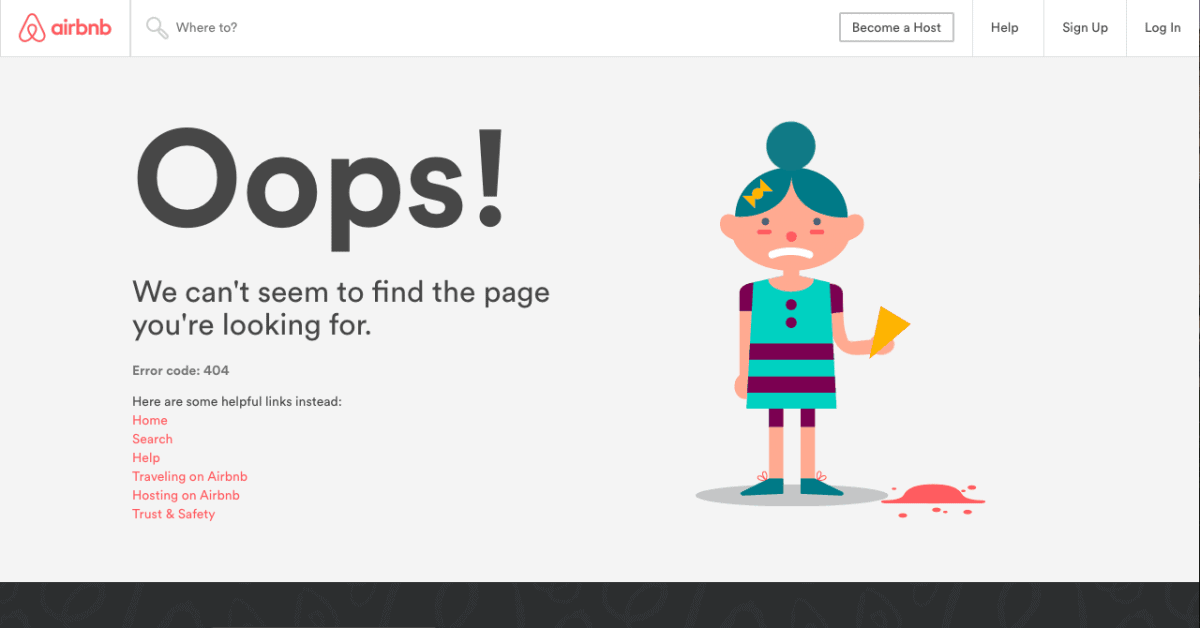
If you use WordPress, you can customize your 404 pages using a plugin, even without any coding skills. Alternatively, you can use your theme’s pre-made template.
The purpose of a good 404 page is to prevent users from bouncing by giving them relevant information and helping them navigate to other pages that are working properly.
4.2.18. Use engaging images and videos to drive engagement
Images and videos naturally increase engagement, which is why Facebook posts with images receive 2.3x more shares than those without.
Adding relevant, optimized images that encourage people to fully engage with your content can also encourage people to learn more about your brand and help you get a good bounce rate.

But the effectiveness of videos far exceeds that of images:
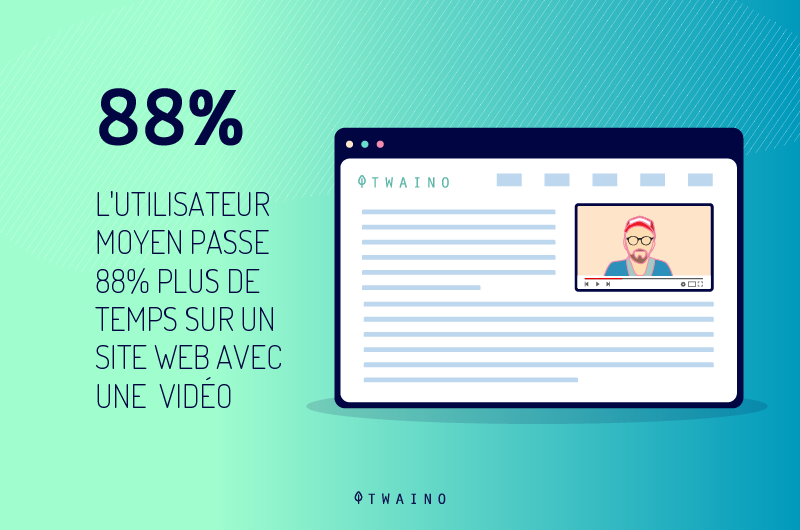
In addition, with videos, the bounce rate can improve by 34%:
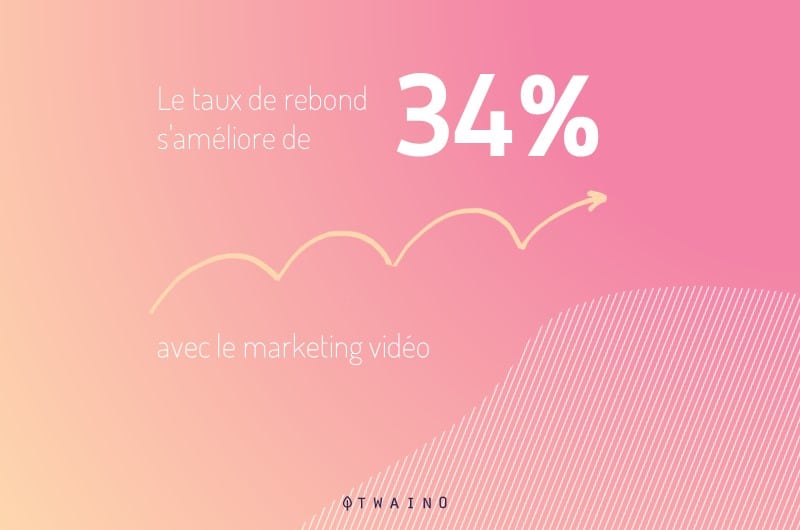
Don’t forget to review the type of files you add to make sure they don’t affect your loading time.
Getting visitors to stay on your page and engage more with your site makes a huge difference in your content performance. This will allow Google to view your site more favorably.
4.2.19. Improve the quality of your website design
Content is supposed to be king, but if your website doesn’t have a design that engages your visitors, they may never even read the content!
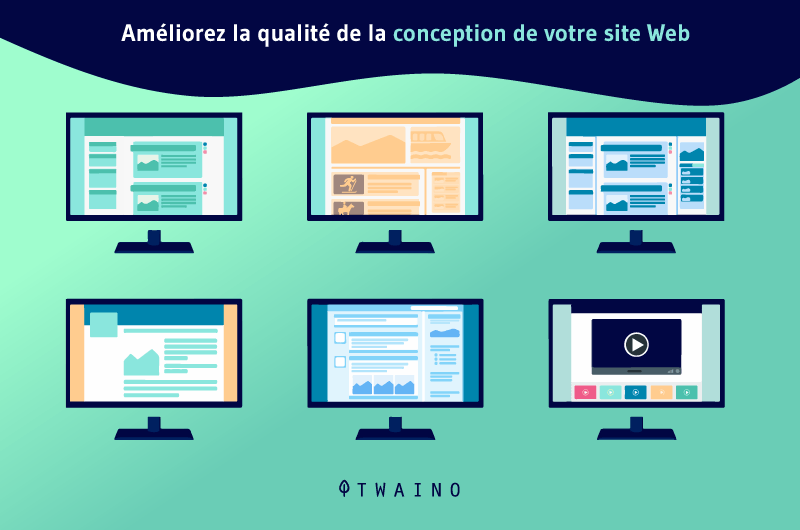
There are statistics that claim that visitors judge the credibility of a website based on the design in a split second.
I know that if I visit a website and the design is horrible, I often leave right away, and I know I’m not the only one.
In this infographic, here are the elements you need to consider for the design of a user-friendly page:

And for the design of your homepage, here are 5 essential elements to consider:
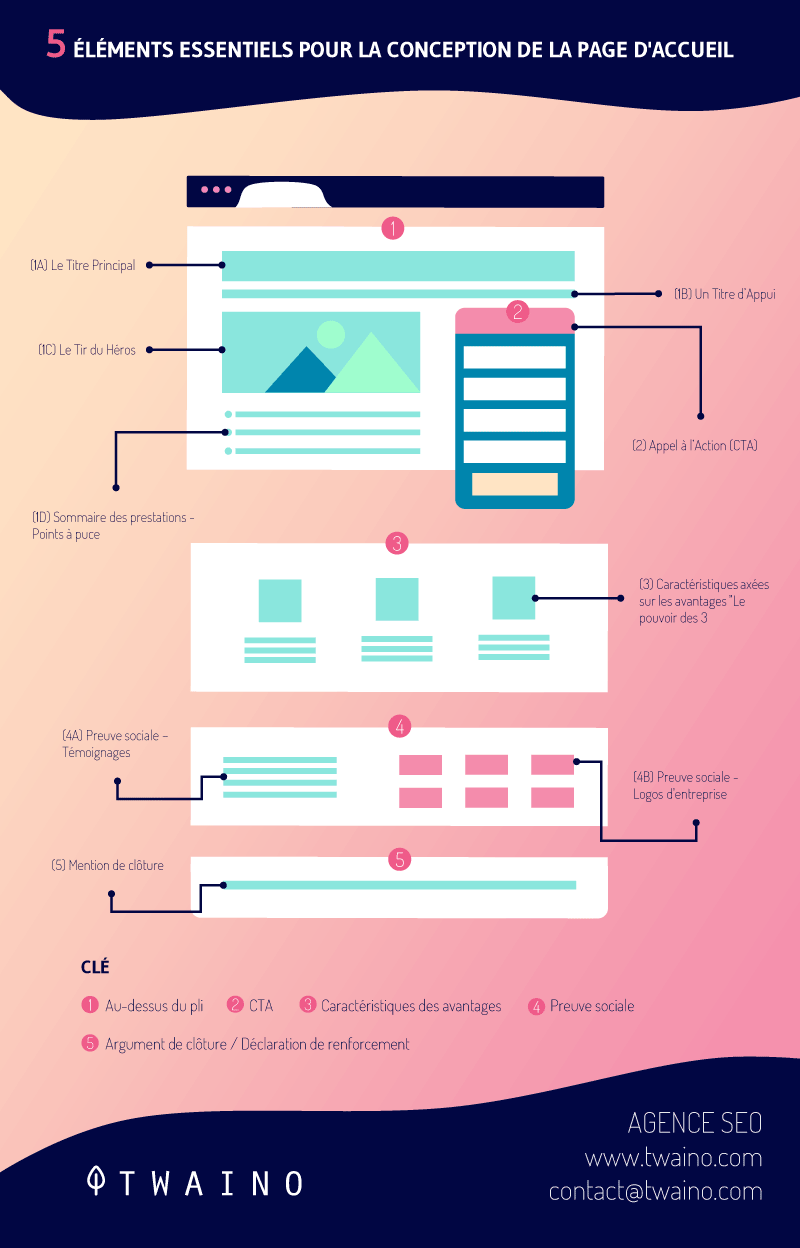
If you have invested time in creating engaging content, also spend time designing your website to properly display that content. The two go hand in hand. A website’s design can be a big factor in its bounce rate.
4.2.20. A/B test relentlessly
You won’t always know the best way to modify a page to reduce bounce rates. And testing each modification one by one is tiring and inefficient. The best option is multivariate testing.
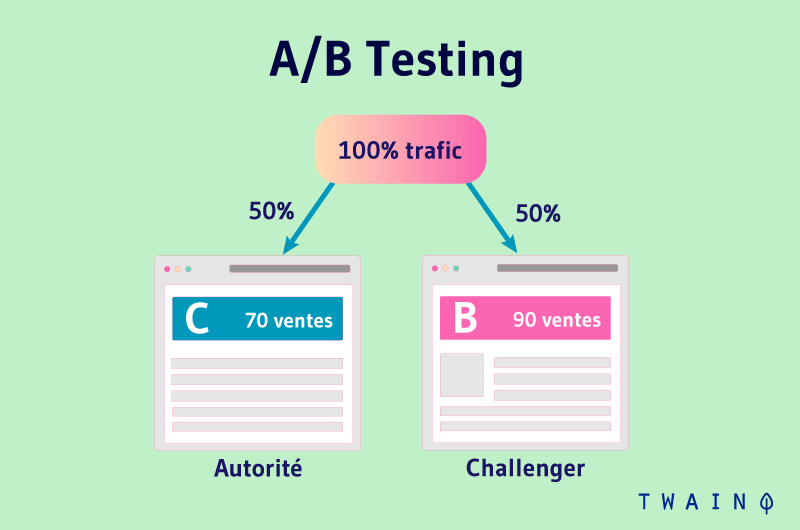
You can test multiple versions of the same page and compare the results of each. This allows you to quickly understand which pages are really producing results!
When your bounce rates are high, B testing will help you find ways to lower them.
4.2.21. Don’t obsess over bounce rate
You shouldn’t focus on optimizing bounce rate, but onimproving user experience. Thus, the rebounds will be automatically improved.
The easier your content is to access and the more relevant it is to your visitor, the more likely they will be to view your pages.
In general, you need to create a great user experience for those who land on your website. And this happens through the points that we have seen previously.
In short, the site should be:
- Easy to navigate;
- Adapted to their needs;
- Easy to read ;
- Personalized.
The content your visitors see should reflect what you know about them. If the visitor has visited the site before, offering content suggestions based on past interests can help.
navigation and site visitors. Content that fits well with the query that brought users to the page and thus meets their needs will also boost your bounce rate.
Finally, using features such as titles, bullet points and lists makes content easier to digest and understand, making it more engaging for your visitors.
Before ending, I would like to address a final chapter in which I will provide answers to some frequently asked questions.
Chapter 5: Other questions asked about the bounce rate
5.1. What does bounce rate mean?
Generally speaking, the bounce rate represents the percentage of people who left your website right after landing on the first page.
For example, a 60% bounce rate means: 6 out of 10 visitors left the site immediately after landing on the first page.
5.2. What do you mean by high bounce rate?
A high bounce rate usually indicates that the site entry pages are not relevant to your website visitors. In this case, you can only expect very few, if any, conversions or sales.
5.3. What does a 100% bounce rate mean?
A 100% bounce rate means that every person on that page returns without visiting another page on the same website.
5.4. What is a good bounce rate?
Normally, your bounce rate should be between 26% and 70%. On average, you should keep it between 41% and 55%. However, if you could reduce it to 26% – 40%, that would be great.
Please note, however, that there is not a fixed percentage of bounce rate, as it varies depending on the site and its sector. You will find more details in Chapter 2.
5.5. How is the bounce rate calculated?
The bounce rate is generally calculated as follows:
Bounce rate = Number of bounces / Total number of visits
5.6. How important is the bounce rate?
The importance of bounce rates is justified by the fact that they can let you know if content is relevant or appreciated by site visitors.
For example, a high bounce rate on your homepage is a bad sign. This indicates that people only view this page and immediately bounce back.
5.7. Is a high bounce rate good or bad?
Generally, a bounce rate ranging from 26-40% is fine. The one ranging from 41% to 55% is about average. And finally, 56-70% is above average, but may be normal for certain types of websites.
5.8. How can I improve my bounce rate?
Some tips to reduce the bounce rate on your website:
- Understand above all what a good rate is for your site;
- Try to understand why visitors leave so early;
- Design a better user experience.
- Make sure the website is responsive;
- Create landing pages that respond exactly to the headlines that show up in the SERP;
- Perform A/B testing;
- Use different visuals to capture visitors’ attention as quickly as possible.
5.9. What is the difference between bounce rate and exit rate?
often thought to Bounce and exit rate be synonymous, or ultimately provide the same data. This is a huge mistake that can lead to false bounce rate analysis and poor decision making.
the Bounce rate percentage of visitors who leave a website without visiting another web page on the same site.
The exit rate on the other hand provides information about specific pages of the website, measuring the percentage of visitors who left the site after viewing a specific page, regardless of the number of pages they visited before in the website. session.
In other words, all bounces are exits, but not all exits are bounces.
5.10. Bounce rates on small mobile devices are equal to those on desktops?
NOPE ! Desktop visitors bounce an average of 42% of the time.
On the other hand, you should expect mobile bounce rates to be up to 15% higher than desktop numbers.
The distinction between mobile bounce rate percentages and that desktop can be even more evident in lead generation websites due to the need to fill out large forms on one page.
The expected bounce rate for tablets is up to 7% higher than the desktop bounce rate.
A much higher percentage for mobile devices may indicate that the website is not optimized for small screens.
5.11. Does a bounce count as a session?
In Google Analytics, a bounce is counted as a session that triggers the Google Analytics server.
5.12. Does Bounce Rate Affect SEO?
No bounce rate directly your website’s SEO. If your bounce rate is stable, then you are providing a good user experience.
Indeed, Google recently announced a new update to its algorithm in an official post that is based onuser experience.
This means that from now on, the evaluation of sites will alsobe based on how users manage to interact with their various web pages.
Sites with a poor user experience will now be overlooked by Google.
This update is called “Google Page Experience” and must take into account the various factors listed in Chapter 4.
In short, a good bounce rate is the result of a good user experience and therefore a good ranking on the SERP.
Bottom Line:
Bounce rate is a key metric because it tells you a lot about your digital marketing, relevance, and user experience. Keep a constant eye on your bounce rate to make sure you keep it under control.
Too many bounces can hinder your conversions, and sometimes even affect your SEO.
Although having a high bounce rate usually has a negative connotation in some cases, it is quite normal in other cases (single page websites).
For even more accurate insights, be sure to cross-reference your bounce rate with other metrics such as “time spent” on your site. This will help you diagnose the exact problem area that needs attention.
I hope you now know what a bounce rate is, how to analyze it and detect problems. Use the information listed in this guide to normalize your bounces and increase your conversion rate.
If you have any other concerns, please let me know in the comments.
Thank you and see you soon !

